Street Life Studies
Context
In a moment of time when the balance between the public and the private is, arguably, shifting in favour of the latter, it is important that a close eye is kept on the status of public space in our cities. Vital public space tends to emerge as a product of numerous competing forces. Attitudes, planning guidelines and levels of enforcement can strangle or let flourish the behaviours which can enliven these places so key to cities. The course is an opportunity to better understand the potentials and limitations of these diverse conditions.
Street Life Studies puts forward the premise that the vitality of public spaces hinges on their ability to facilitate a diversity of, often unexpected, usages, movements and interactions, by a broad spectrum of people, over varying time periods. It suggests that the street, as the fundamental public space of the city, is where this activity can and should occur.
Within this framework, the course suggests designers take an active role in engaging first hand with the complex layers of place, in this case the street, throughout the design process. This intrinsically means an engagement not only with space but with the people who use it.
The course analyses two very different street environments; Lakemba in Sydney and Khan Daun Penh in Phnom Penh. These places hold in common both imminent change and clear expression of streetlife. Not without their challenges, Phnom Penh streets see diverse urban dwellers playing out much of their lives in the public domain. Street space is appropriated by its users in a ‘bottom-up’ manner to meet varying needs, rather than emerging as a result of those involved in the broader level design and legislation of the built environment. In Sydney, this kind of mixed informal activity is much less apparent. The built street space itself is not dissimilar but usage centres upon vehicular and pedestrian circulation and regulation of activity is significantly more controlled. Opportunities and constraints of each place can be understood through observation and comparison.
Course overview
The course runs for one week in Sydney and two weeks in Phnom Penh, in January each year. Students work in interdisciplinary and transcultural groups to engage with the spaces, people and systems of the street.
Phase One: STREETLIFE OBSERVATION consists of students working in groups to undertake on-field analysis of urban streets in selected areas of Sydney and Phnom Penh. Using hand drawing and simple data collection, students are guided through a series of observational exercises. They identify, document, and analyse the spaces, systems, users and usages of each street environment. The drivers behind spacio-behavioural patterns are interpreted as as a way to begin to understand the needs of those who use the streets.
Phase Two: STREETLIFE INTERVENTION asks students to use their street observations as design ‘evidence’ to inform an urban brief and intervention. Propositions must be small-scale yet scalable,with the overall aimof fostering vital, people-centred public street space. The course encourages students to challenge their understanding of design intervention as purely physical and ‘provided’ by the designer or legislator to consider design systems and strategies developed with and by end users. Students consider how transcultural precedents might inform approaches across cities.
Partnerships
Street Life Studies has been built, and relies upon, ongoing relationships developed from 2010 between:
University of New South Wales Sydney, Built Environment
The Royal University of Fine Arts, Faculty of Architecture and Urbanism
Sa Sa Art Projects
The Vann Molyvann Project
Khmer Architecture Tours
STREET LIFE STUDIES 2018/19. Built Environment, University of New South Wales, Sydney. Architecture and Urbanism, Royal University of Fine Arts, Phnom Penh. www.streetlifestudies.wordpress.com


STREET LIFE STUDIES 2018/19.
Environment,
www.streetlifestudies.wordpress.com
Built
University of New South Wales, Sydney. Architecture and Urbanism, Royal University of Fine Arts, Phnom Penh.
Lakemba, sydney
khan Daun penh, phnom penh
course process
COURSE PROCESS



PROCESS process
PROCESS process
(in a nutshell) how do we learn about street life?
to inform
STUDY STREETLIFE ON-FIELD OBSERVATION
STUDY STREETLIFEDIRECT OBSERVATION
URBAN INTERVENTION
STUDY STREETLIFEDIRECT OBSERVATION


General information and registration of interaction activities on Y Street, Prahran, Melbourne.
study street life using
study street life using
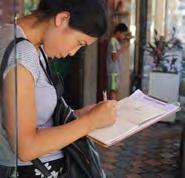

using


General information and registration of interaction and activities on Y Street, Prahran, Melbourne.
to inform direct observation
to inform direct observation











TACTICAL URBANISM USING
tactical urbanism
tactical urbanism
TACTICAL URBANISM USING




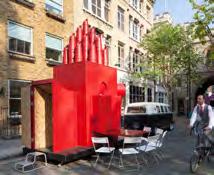
TO INFORM
TO INFORM USING
TO INFORM
“Construct situations rather than objects, design processes that can result in chance meetings ...leaving room for users to adapt and appropriate space.”
repeat in two cities
STREET LIFE STUDIES 2018/19. Built Environment, University of New South Wales, Sydney. Architecture and Urbanism, Royal University of Fine Arts, Phnom Penh. www.streetlifestudies.wordpress.com
Atelier Bow Wow
"The direct observations help to understand why some spaces are used and others are not."
Jan Gehl
Sydney Phnom Penh
what is streetlife?
Street Life Studies takes a people-centred approach to understanding place. It examines relationships between:

People, their behaviours and their stories + Physical space +
Systems that connect these
Formal, planned layers of place +
Informal, unplanned layers of place + the overlaps between these
STREET LIFE STUDIES 2018/19. Built Environment, University
www.streetlifestudies.wordpress.com
of New South Wales, Sydney. Architecture and Urbanism, Royal University of Fine Arts, Phnom Penh.
strategic context
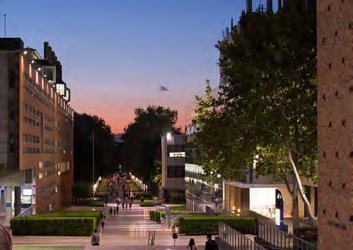
11.3
By 2030, enhance inclusive and sustainable urbanization and capacity for participatory, integrated and sustainable human settlement planning and management in all countries
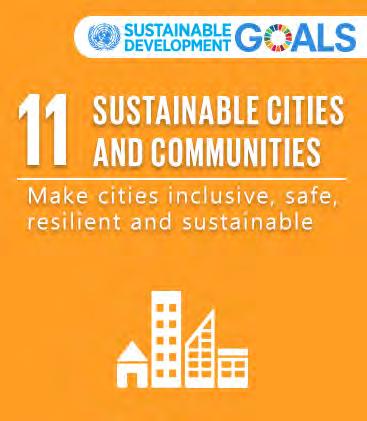
11.4
Strengthen efforts to protect and safeguard the world’s cultural and natural heritage
11.7
By 2030, provide universal access to safe, inclusive and accessible, green and public spaces, in particular for women and children, older persons and persons with disabilities
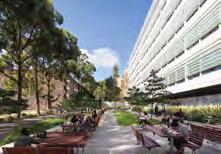
11.7.1
Average share of the built-up area of cities that is open space for public use for all, by sex, age and persons with
STREET LIFE STUDIES 2018/19. Built Environment, University of New South Wales, Sydney. Architecture and Urbanism, Royal University of Fine Arts, Phnom Penh. www.streetlifestudies.wordpress.com
disabilities 2 03 04 06 07 08 10 11 12 17 23 27 31 From the Chancellor From the President and Vice-Chancellor UNSW Vision UNSW 2025 Our Commitment Our Strategy in Context The UNSW Strategic Matrix Strategic Priorities Strategic Priority A: Academic Excellence 13 A1: Research quality – a world leader 15 A2: Educational Excellence - The UNSW Scientia Educational Experience Strategic Priority B: Social Engagement 18 B1: A just society 20 B2: Leading the debate on Grand Challenges 21 B3: Knowledge exchange for social progress and economic prosperity Strategic Priority C: Global Impact 24 C1: UNSW model of internationally engaged education 25 C2: Partnerships that facilitate our strategy 26 C3: Our contribution to disadvantaged and marginalised communities Enabling Delivery of Our Strategy 28 D1: People and culture 29 D2: Operational effectiveness and sustainability 30 D3: World-class environments Next steps
the course focuses on understanding people and place through:
STREET LIFE STUDIES 2018/19. Built Environment, University of New South Wales, Sydney. Architecture and Urbanism, Royal University of Fine Arts, Phnom Penh. www.streetlifestudies.wordpress.com
immersion
on-field observation
Emphasis on understanding, through observation and exchange.
Design proposition as secondary.
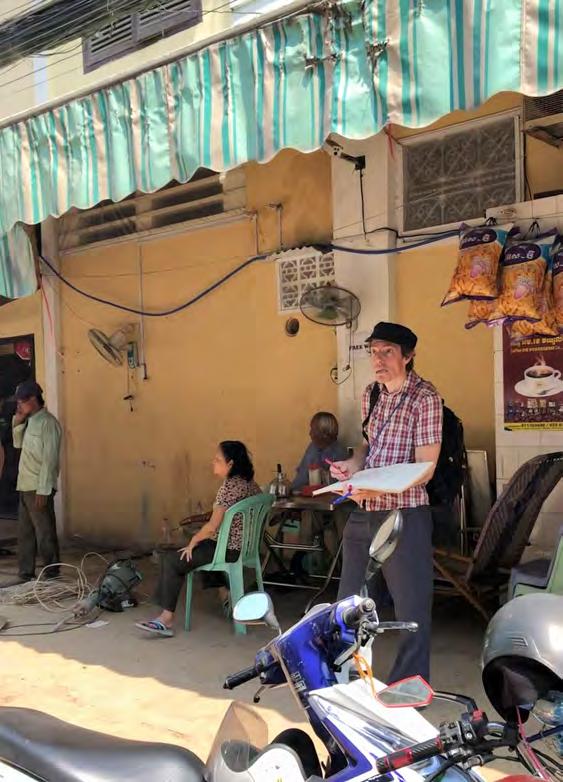
STREET LIFE STUDIES 2018/19. Built Environment, University
www.streetlifestudies.wordpress.com
of New South Wales, Sydney. Architecture and Urbanism, Royal University of Fine Arts, Phnom Penh.
knolwedge exchange
Emphasis on two-way learning. What can we learn? What can we share?

STREET LIFE
STUDIES 2018/19. Built Environment, University of New South Wales, Sydney. Architecture and Urbanism, Royal University of Fine Arts, Phnom Penh. www.streetlifestudies.wordpress.com
interdisciplinary and transcultural collaboration
Emphasis on leveraging diverse disciplinary and cultural backgrounds.

STREET LIFE STUDIES 2018/19. Built Environment, University
New South
www.streetlifestudies.wordpress.com
of
Wales, Sydney. Architecture and Urbanism, Royal University of Fine Arts, Phnom Penh.
local, long term partnerships
Sustained and growing collaborations with locally-based groups linked to course themes.
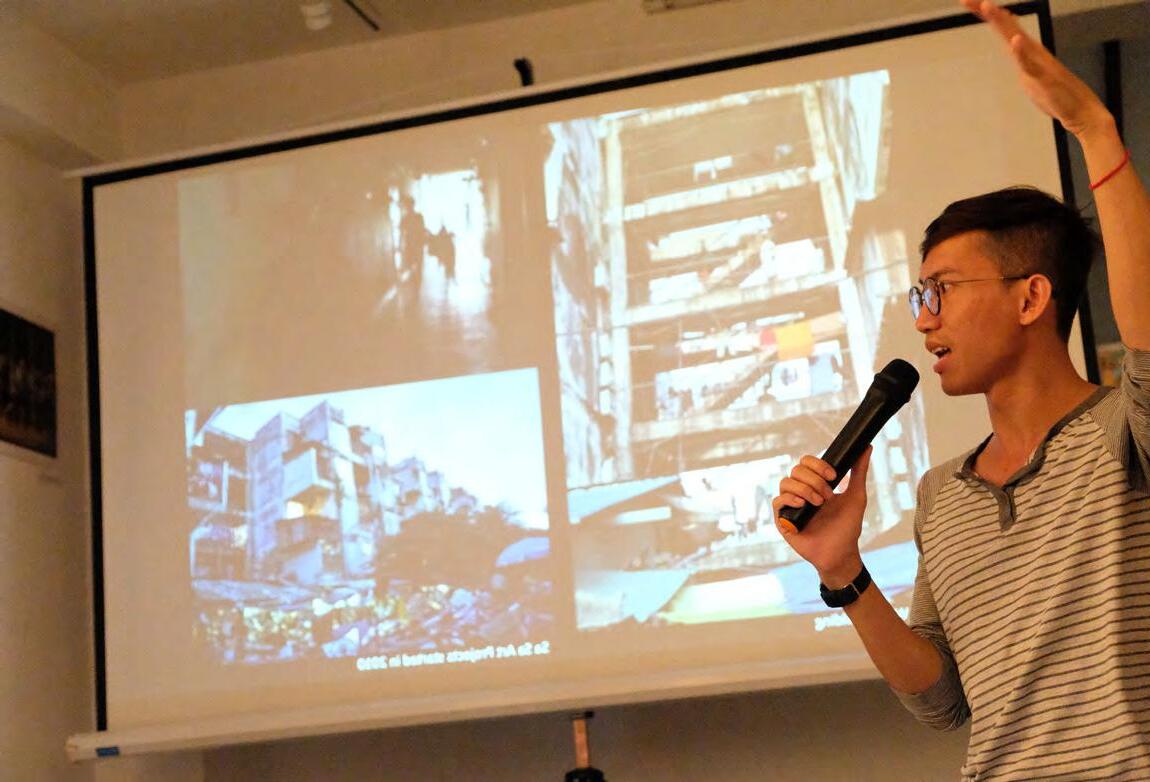
Sa Sa Art Projects
The Vann Molyvann Project
Khmer Architecture Tours
STREET LIFE STUDIES 2018/19
Environment,
www.streetlifestudies.wordpress.com
. Built
University of New South Wales, Sydney. Architecture and Urbanism, Royal University of Fine Arts, Phnom Penh.
exploration of place
Emphasis on active exploration of people and place within and outside of coursework.
Walk, talk, look, eat, drink, play.

STREET LIFE STUDIES
www.streetlifestudies.wordpress.com
2018/19. Built Environment, University of New South Wales, Sydney. Architecture and Urbanism, Royal University of Fine Arts, Phnom Penh.
cross cultural comparison
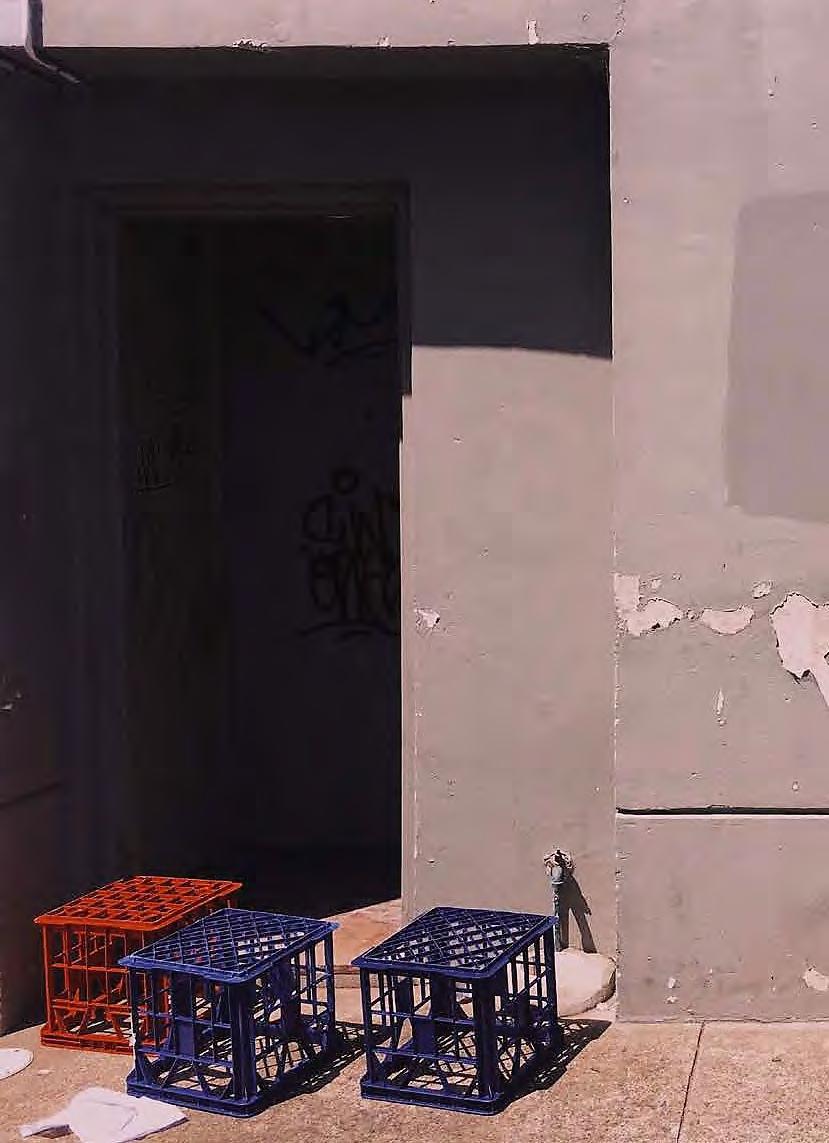
Reflect on findings through comparison. Can we intelligently translate principles from one context to another?

STREET LIFE
STUDIES 2018/19. Built Environment, University of New South Wales, Sydney. Architecture and Urbanism, Royal University of Fine Arts, Phnom Penh. www.streetlifestudies.wordpress.com
hand drawing
Drawing as a means to a slowly immerse and analyse.

STREET LIFE STUDIES 2018/19.
www.streetlifestudies.wordpress.com
Built Environment, University of New South Wales, Sydney. Architecture and Urbanism, Royal University of Fine Arts, Phnom Penh.
course work
Phase 1: Streetlife Observations
Phase 2: Streetlife Interventions
STREET LIFE STUDIES 2018/19. Built Environment, University of New South Wales, Sydney. Architecture and Urbanism, Royal University of Fine Arts, Phnom Penh. www.streetlifestudies.wordpress.com
streetlife observations
Phase one of the course asks students to undertake on-field analysis of urban streets in selected areas of Sydney and Phnom Penh. They examine streets and the life they host through the lens of a given theme; healthy cities, slow cities, the face of the city, porous cities.
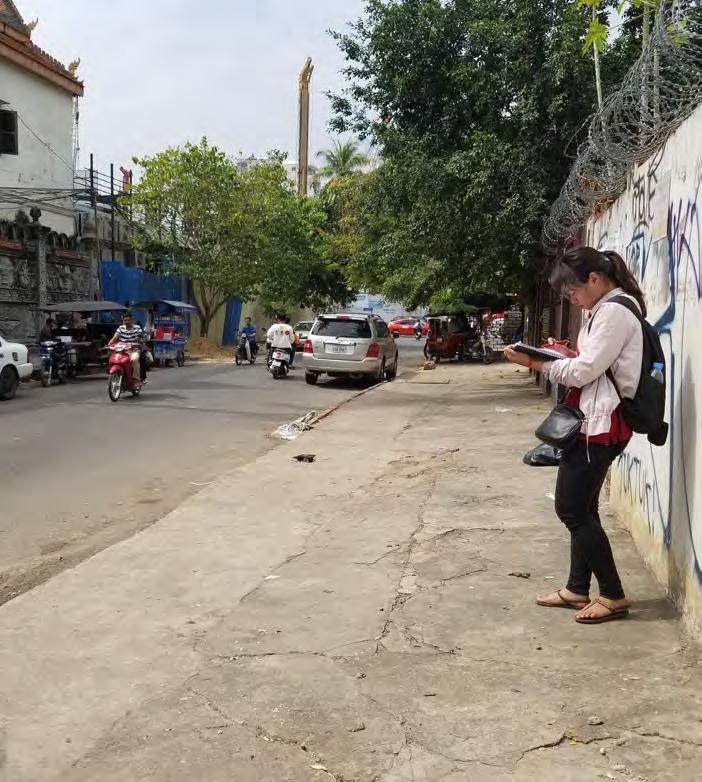
Guided by a series of observational exercises within each theme, students use hand drawing and simple data collection to identify and deconstruct the physical, behavioural and systematic layers of each street space. They interpret key patterns and the driving forces behind their findings then communicate these using basic post-production techniques.
Students are encouraged to consider the street environment as it was intended to be used versus its actual use and the factors that might influence scenarios observed.
STREET LIFE STUDIES 2018/19. Built Environment, University of New South Wales, Sydney. Architecture and Urbanism, Royal University of Fine Arts, Phnom Penh. www.streetlifestudies.wordpress.com
"Streets and their sidewalks-the main public places of a city-are its most vital organs."
Jane Jacobs
“While architects and urban planners have been dealing with space, the other side of the coin – life – has often been forgotten.”
Jan Gehl
phase 1:
noise smell sun shade
Critical response
Ribus, quis eos ni aliquat ibusapiciam, sitas quam cum et eum dunde pos esto dolupta earum seque quatur? Qui dolest eostem hario mi, conseque prehenisci tem elestotas perepti ratatus, omnimpe rspient rempossime non eum, sinctemquis dolum sit volorepro maximagnis sunt que ni iuntota tquae. Ut quamus, offici dolupitio voloria comniss iminus re earchitassit volorae pedigen tendiandis ea est res as suntiation periae mod most utecat.
Ribus, quis eos ni aliquat ibusapiciam, sitas quam cum et eum dunde pos esto dolupta earum seque quatur? Qui dolest eostem hario mi, conseque prehenisci tem elestotas perepti ratatus, omnimpe rspient rempossime non eum, sinctemquis dolum sit volorepro maximagnis sunt que ni iuntota tquae. Ut quamus, offici dolupitio voloria
Critical Response
Environmental considerations
Critical response
Sydney Monyneath Chan
Observe several street sections. What environmental factors influence street use?
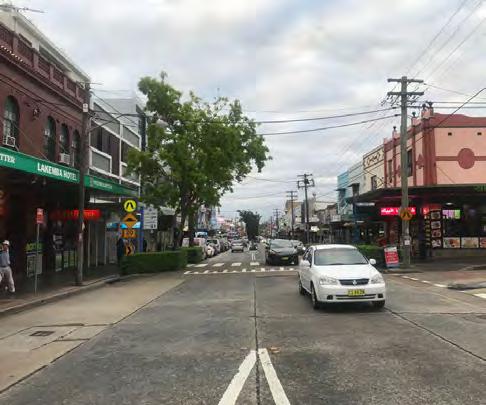


PHOTO
Lakemba, Syndey Panayiota Achilleos
Ribus, quis eos ni aliquat ibusapiciam, sitas quam cum et eum dunde pos esto dolupta earum seque quatur? Qui dolest eostem hario mi, conseque prehenisci tem elestotas perepti ratatus, omnimpe rspient rempossime non eum, sinctemquis dolum sit volorepro maximagnis sunt que ni iuntota tquae. Ut quamus, offici dolupitio voloria comniss iminus re earchitassit volorae pedigen tendiandis ea est res as suntiation periae mod most utecat.
Planned Modified Activities Users Sidewalk Road Layers Focus area City Author

Ribus, quis eos ni aliquat ibusapiciam, sitas quam cum et eum dunde pos esto dolupta earum seque quatur? Qui dolest eostem hario mi, conseque prehenisci tem elestotas perepti ratatus,
My main focus for observation one is Haldon Street and the key environmental factors that affect the street use. I found that the sun and shade diagram of Haldon street is like a triangle, where the area of sunlight decreases and there are more and more shaded areas as you walk from The Boulevarde down to Gillies street. This largely shape the pedestrian activity level. What I also found interesting what that people do not seem mind walking or sitting around smelly and noisy areas as long as there is shade.
Monyneath Chan, 3rd yr, Architectural Studies
Ribus, quis eos ni aliquat ibusapiciam, sitas quam cum et eum dunde pos esto dolupta earum seque quatur? Qui dolest eostem hario mi, con seque prehenisci tem elestotas perepti ratatus, omnimpe rspient rempossime non eum, sinctem quis dolum sit volorepro maximagnis sunt que ni iuntota tquae. Ut quamus, offici dolupitio voloria comniss iminus re earchitassit volorae pedigen tendiandis ea est res as suntiation periae mod most utecat.
smell noise walking sitting/standing
STREET LIFE STUDIES 2018/19. Built Environment, University of New South Wales, Sydney. Architecture and Urbanism, Royal University of Fine Arts, Phnom Penh. www.streetlifestudies.wordpress.com
PHOTO Drawing type | Time | Location | Weather Drawing type | Time | Location | Weather Drawing type | Time | Location | Weather Item 1 facade sidewalk/road in/out threshold Focus area City Author
Section Section Section noise sitting/standing
SYDNEY
Item 1 Item 2 Item 3 Item 4 Item 5 planned modified users activities facade sidewalk/road in/out threshold Layers Focus area City Author
Data diagrams Sydney Monyneath Chan
My main focus for observation one is Haldon Street and the key environmental factors that affect the street use. I found that the sun and shade diagram of Haldon street is like a triangle, where the area of sunlight decreases and there are more and more shaded areas as you walk from The Boulevarde down to Gillies street. This largely shape the pedestrian activity level. What I also found interesting what that people do not seem mind walking or sitting around smelly and noisy areas as long as there is shade.
Ribus, quis eos ni aliquat ibusapiciam, sitas quam cum et eum dunde pos esto dolupta earum seque quatur? Qui dolest eostem hario mi, con seque prehenisci tem elestotas perepti ratatus, omnimpe rspient rempossime non eum, sinctem quis dolum sit volorepro maximagnis sunt que ni iuntota tquae. Ut quamus, offici dolupitio voloria
Sunlight, noise, and smell are all elements that have a direct impact on inhabitants and how they occupy the street. Through my observations, it became evident that the intensity of the sunlight and heat would thrust inhabitants to cross the pedestrian very quickly to get back under the awning for shade. This behaviour is further impelled by the surrounding noise of the traffic. The nature of the traffic upon Hardon Street also plays a factor in the instant manner in which people cross the road. Noise and smell have instilled a conceptual path throughout the street with the inclusion of music and strong aromas of food; ultimately creating a space for pedestrians to retrieve too. These elements skillfully present an opportunity for one fully emesre themselves into the culture of the area as they are able to use their senses to explore, observe and admire the Streets of Lakemba.
Observe several street sections. What environmental factors influence street use?
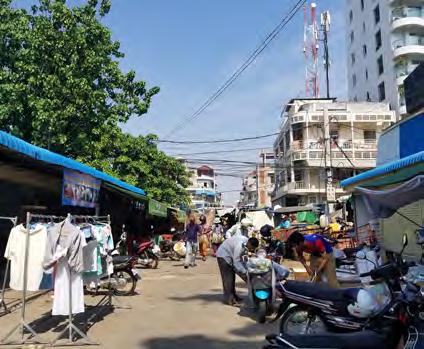

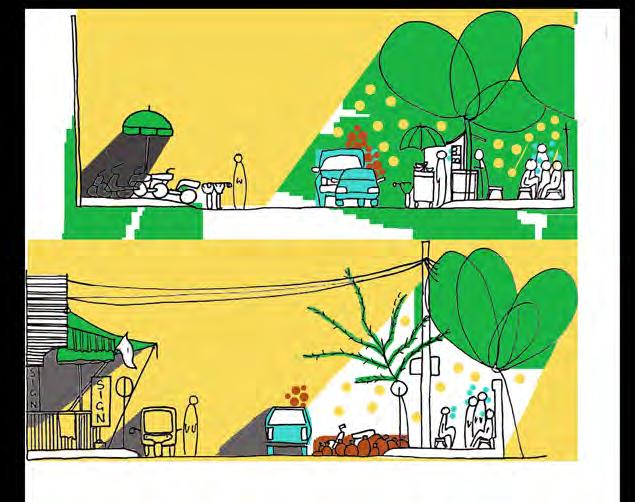
STREET LIFE STUDIES 2018/19. Built Environment, University of New South Wales, Sydney. Architecture and Urbanism, Royal University of Fine Arts, Phnom Penh. www.streetlifestudies.wordpress.com Sunlight Shade Observation 01 Section 3 | 9am | Phnom Penh | Sunny Sunlight Shade Noise Air Pollution Protection 1 2 3 4 5m Observation 01 Street Use Section 3 | 9am | Phnom Penh | Sunny Section 2 | 9am | Phnom Penh | Sunny Section 1 | 9am | Phnom Penh | Sunny PHNOM PENH Environmental
considerations
Rebecca Donney, 3rd yr, Interior Architecture (Hons)
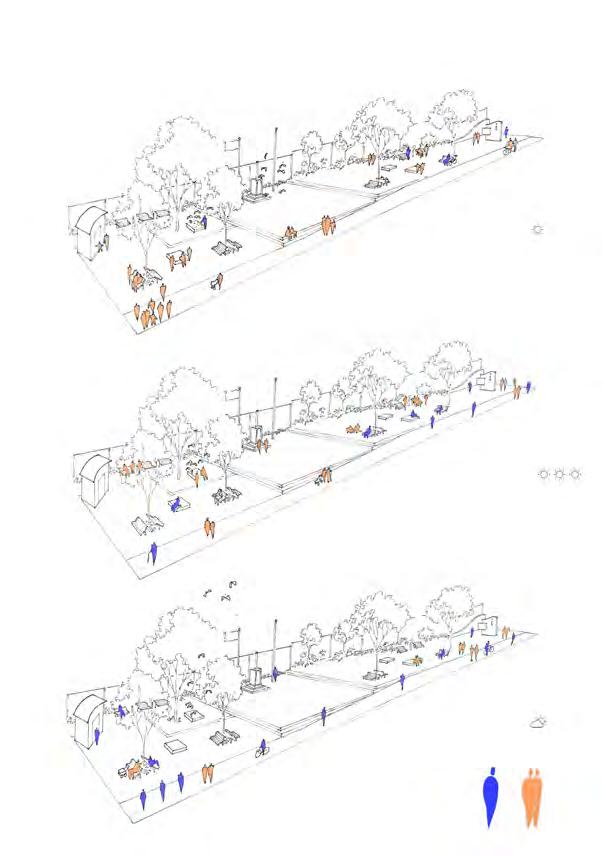






STREET LIFE STUDIES 2018/19. Built Environment, University of New South Wales, Sydney. Architecture and Urbanism, Royal University of Fine Art, Phnom Penh. Course Coordinator EVA LLOYD
PHNOM PENH
Street demographics
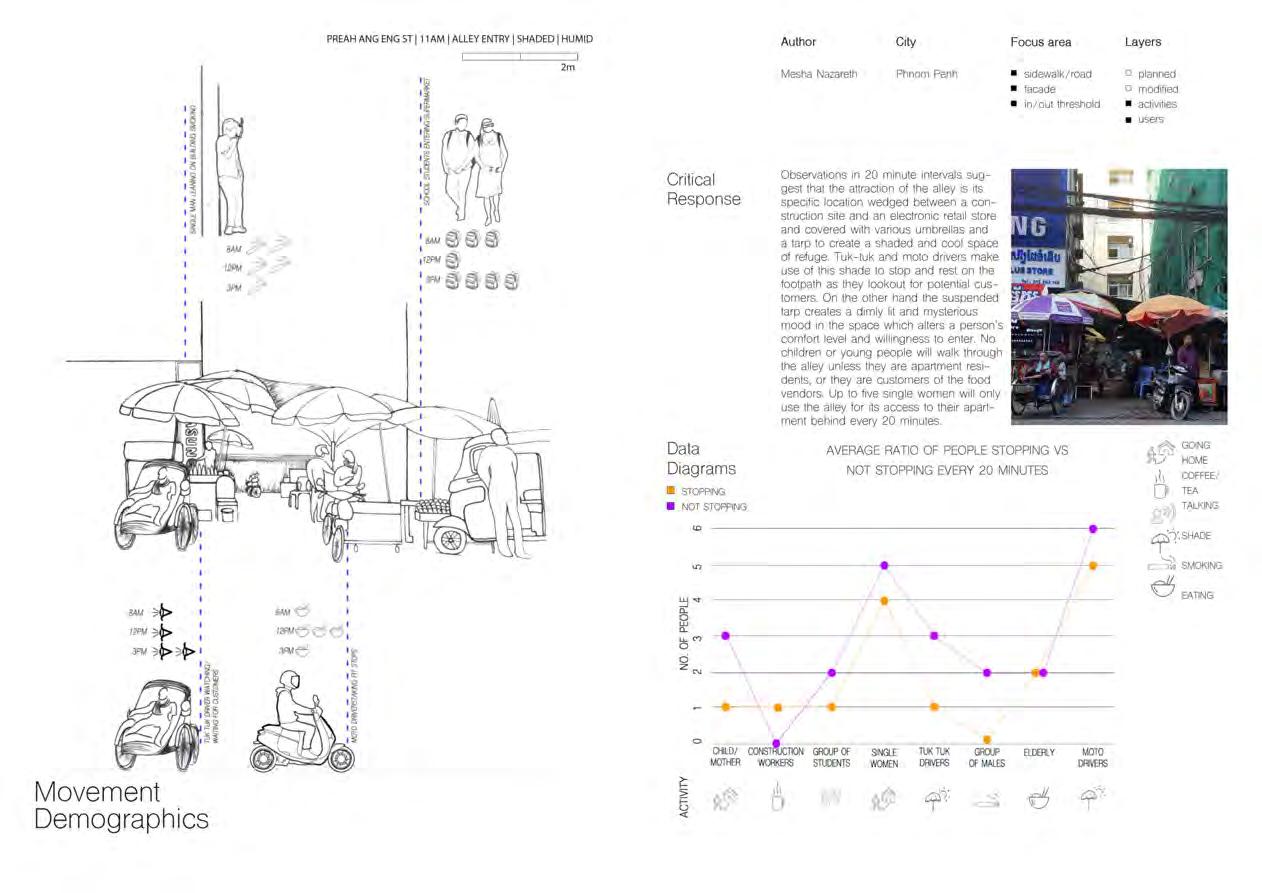
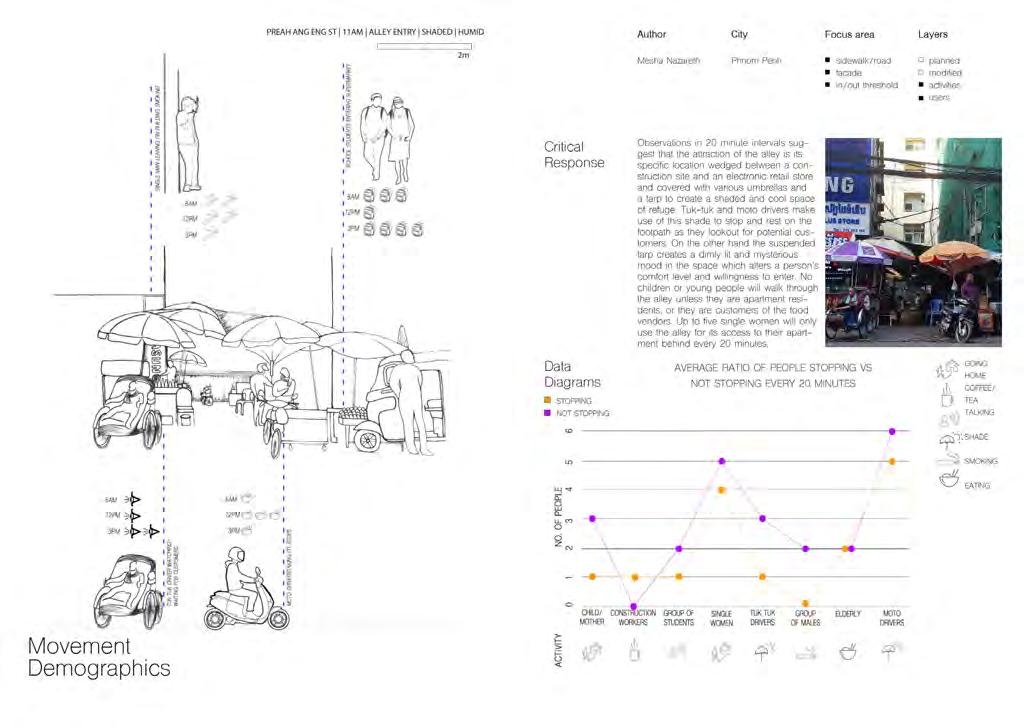
Built Environment, University of New South Wales, Sydney. Architecture and Urbanism, Royal University of Fine Art, Phnom Penh. Course Coordinator EVA LLOYD
SYDNEY Facade Appropriation
The awnings of Lakemba are used not only for their protective role against rain and sun but also as tools to attract commerce and display identity and on rare occasions religion as well. This is done through signage, lighting and decoration, as well as through the choice of disposition of the various elements.
Observe multiple expressions of one facade component. How and why has it been modified by its users?
The awnings of Lakemba are used not only for their protective role against rain and sun but also as tools to attract commerce and display identity and on rare occasions religion as well. This is done through signage, lighting and decoration, as well as through the choice of disposition of the various elements.
Layers Focus area

Awnings can also be used as storage space for upper levels.
PHOTO
facade facade components


Awnings can also be used as storage space for upper levels.
The chemist, dentist and doctor combination of signs seem to show a deliberate connection between the activities of the lower and upper storey. As a result, the combination of signage works and makes this location a convenient spot.
The awnings of Lakemba are used not only for their protective role against rain and sun but also as tools to attract commerce and display identity and on rare occasions religion as well. This is done through signage, lighting and decoration, as well as through the choice of disposition of the various elements.
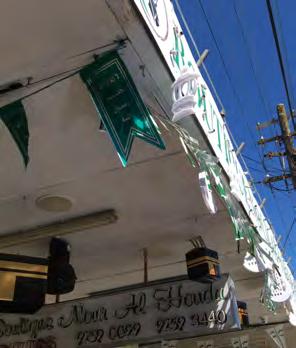
Awnings can also be used as storage space for upper levels.

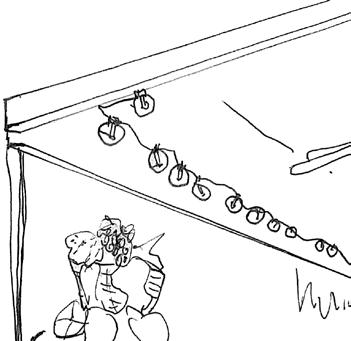





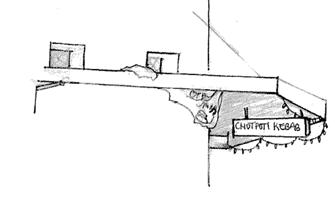
The chemist, dentist and doctor combination of signs seem to show a deliberate connection between the activities of the lower and upper storey. As a result, the combination of signage works and makes this location a convenient spot.
planned modified activities users
The chemist, dentist and doctor combination of signs seem to show a deliberate connection between the activities of the lower and upper storey. As a result, the combination of signage works and makes this location a convenient spot.

Anina Carl, 3rd yr, Landscape Architecture (Hons)

STREET LIFE STUDIES 2018/19. Built Environment, University of New South Wales, Sydney. Architecture and Urbanism, Royal University of Fine Art, Phnom Penh. Course Coordinator EVA LLOYD
3D| 3pm | Paradise Grocery| Sunny 3D| 3pm | Nour Al Houda| Sunny Elevation| 3pm | Chotpoti Kebab| Sunny Elevation| 3pm | Khushboo Restaurant| Sunny Elevation| 3pm | Big Fresh| Sunny Light Decoration Awning Signage Facade Component Awning 3D| 3pm | Chemist| Sunny Layers Focus area Author Name Surname planned modified activities users City Name
diagrams Critical response City sidewalk/road facade facade components 3D| 3pm | Nour Al Houda| Sunny Elevation| 3pm | Khushboo Restaurant| Sunny
Data
Anina Carl Lakemba, Sydney
do not print grey box Identity Religion Status Commerce Security Deterrent Comfort Decoration Light Awning Signage 1 2 3 4 5m 3D| 3pm | Paradise Grocery| Sunny 3D| 3pm | Nour Al Houda| Sunny Elevation| 3pm | Chotpoti Kebab| Sunny Elevation| 3pm | Khushboo Restaurant| Sunny Elevation| 3pm | Big Fresh| Sunny Light Decoration Awning Signage Anti-pest Facade Component Awning 3D| 3pm | Chemist| Sunny Name Surname City Name
diagrams Critical response 3D| 3pm | Nour Al Houda| Sunny Elevation| 3pm | Khushboo Restaurant| Sunny
Data
Anina Carl Lakemba, Sydney Identity Religion Status Commerce Security 3D| 3pm | Nour Al Houda| Sunny Elevation| 3pm | Khushboo Restaurant| Sunny
Author Name Surname
City Name
Critical response City sidewalk/road
3D| 3pm | Nour Al Houda| Sunny Elevation| 3pm | Khushboo Restaurant| Sunny
Data diagrams
Anina Carl Lakemba, Sydney
PHNOM PENH Facade Appropriation

Observe multiple expressions of one facade component. How and why has it been modified by its users?
Layers planned modified activities users
Anina Carl, 3rd yr, Landscape Architecture (Hons)
The awnings of Phnom Penh are much more varied in materiality, size and functionality than in Sydney. The awning owners seem to be more resourceful and less conservative in their design of them and in their use. Awnings are varied in shape from slanted to horizontal, to triangular. Their materiality varies from brick, to iron, thatched bamboo, plastic or fabric.
Awnings are used for shelter from the sun, to provide lighting to the shop at night, to carry the identity of the shop with signage or decoration, to create an atmosphere through the decoration, as well as to provide cooling with fans and plants. Awnings can also be used to hang merchandise, advertisting and to hang elements that create walls in the shape of signs, blinds, grids or merchandise.
Objects completementing awnings will have different functionality: for example umbrellas (for shade) can extend awnings.

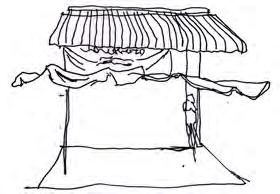

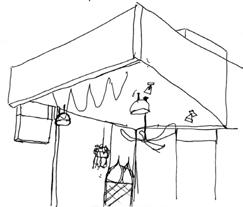
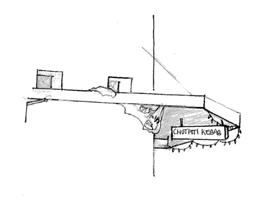

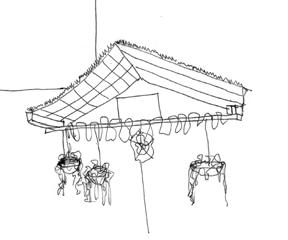
The length of awnings will depend both on aspect (west or south facing) and on the type of activity of the shop (longer for seating, or for food display).

Built Environment, University of New South Wales, Sydney. Architecture and Urbanism, Royal University of Fine Art, Phnom Penh. Course Coordinator EVA LLOYD
sidewalk/road
funcowners and shape triangular. iron, sun, to signage proAwnings cregrids Critical response 1 2 3 4 5m Data diagrams 3D| 3pm | Fruit Shop | Preah Ang Eng St.| Sunny 3D| 3pm | Riverside Palace| Preah Sisowath | Sunny Elevation| 3pm | 19 St. | Knick Knack Shop| Sunny Elevation| 3pm | Lemon Bar | 136 St.| Sunny 3D| 3pm | Fork and Spoon Restaurant| 136 St. |Sunny Light Decoration Shade Signage Commerce
Length Circulation Seating 3D| 3pm | Sun + Moon Restaurant| Sunny Layers Focus area Author Name Surname planned modified activities users City Name Critical response City 1 2 3 4 5m Data diagrams sidewalk/road facade facade components 3D| 3pm | Fruit Shop | Preah Ang Eng St.| Sunny 3D| 3pm | Riverside Palace| Preah Sisowath | Sunny Elevation| 3pm | 19 St. | Knick Knack Shop| Sunny Elevation| 3pm | Lemon Bar | 136 St.| Sunny 3D| 3pm | Fork and Spoon Restaurant| 136 St. |Sunny Light Decoration Shade Signage Commerce Cooling
facade facade components
Facade Component Awning
Anina Carl Phnom Penh
Facade Component Awning Identity Commerce Shade Cooling Atmosphere Lighting Length of Awning Circulation Seating Safety Privacy 3D| 3pm | Sun + Moon Restaurant| Sunny
PHOTO do not print grey box

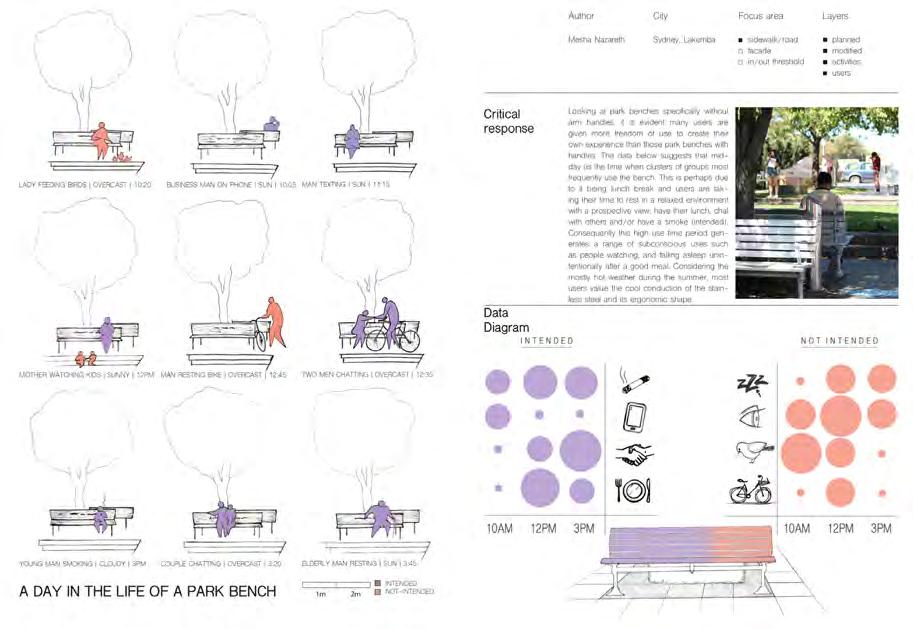
PHNOM PENH A day in the life of a ...
Phnom Penh Theodore B Hardiono

Observe one object on the sidewalk.






How and why is it used over the course of a day?




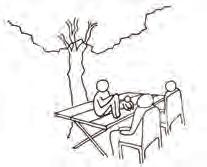
I found this object really interesting because it looks like a table but functions like a bench. To determine the intended and unintended use of this object have analyzed its physical features and how people interact with the object.









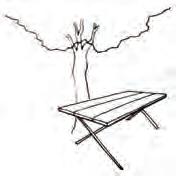


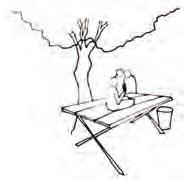





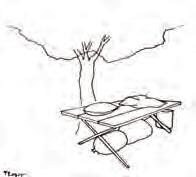
Based on my analysis, believe this object serves as a multifunctional flat top table. Out of all the activities I observed throughout the day, only found one unintended use of the object which is putting trash on.




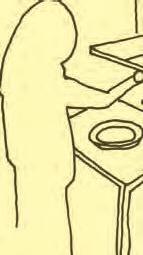


Not only that the object accommodate the interaction on its surface, it also encourage the use of the space underneath. The user can also use this object as a table by adding chairs around it to hold informal gatherings and socials.
Theodore Hardiono, 3rd yr, Industrial Design (Hons)
STREET LIFE STUDIES 2018/19 Built Environment, University of New South Wales, Sydney. Architecture and Urbanism, Royal University of Fine Art, Phnom Penh. Course Coordinator EVA LLOYD
Intended Use OBSERVATION 3 A DAY IN THE
OF
Empty | 8 AM | Sunny Used for storage | 9 AM | Sunny Feeding Child | 11 AM | Sunny Kids Playing Around | 2 PM | Sunny Browsing Phone | 3 PM | Sunny Playing with Baby | 12:30 PM | Sunny Sit Around | 7:30 PM | Clear Sky Leave Trash Behind | 10:30 PM | Clear Gather Informally | 5:30 PM | Sunny PHOTO
LIFE
A...
Top Structure Bottom Structure Surface Material Wood Easily Replaced Surface Width Stability Basic Rectangular Shape Height Kids can play around without worrying of breaking the object Shape promotes gatherings Object misused as place to gather waste The wide surface accommodates multiple activities to happen simultaneously Underneath for Storage Activities that require different elevation planned modified activities users sidewalk/road facade in/out threshold Layers Focus area City Author Data diagrams Critical response
SYDNEY
LAKEMBA, NSW ALLISON MILLER
Threshold Porosity
Critical Response
5m OBSERVATION 01: THRESHOLD POROSITY
Data
Diagrams
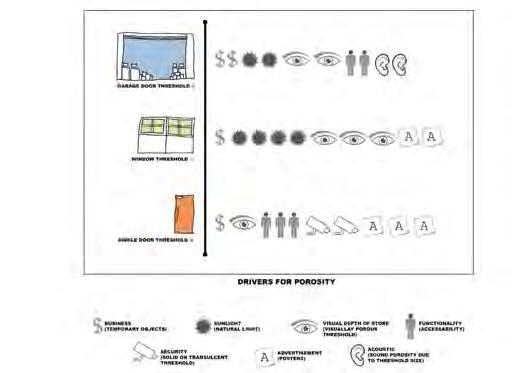
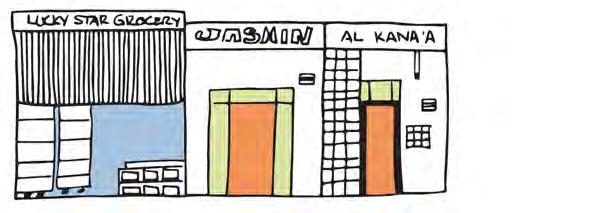
Looking at the threshold typologies around Haldon Street in Lakemba there were a large range of openings and shop fronts that differed in porosity due to a range of driving factors. The data below displays the comparison of the three main threshold sizes and their drivers for porosity. Garage door type thresohlds have equal consideration (whether accuratly planned or not) conveying business, sunlight, visual depth, functionality and acoustic facotrs as balanced drivers; found typically to be used for grocers. Whereas, window thresholds were clearly used for the use of natural light to flood an interior for more commercial spaces; and lastly the single door openings were used for functionality and typically private typologies (ie. apartments or medical centres).
Observe several internal/external building thresholds. How does the porosity of the threshold affect streetlife?


SHOP FRONT TEMP. OBJECTSTHRESHOLD OPENING
Allison Miller, 2nd yr, Interior Architecture (Hons)
SHOP FRONT TEMP. OBJECTSTHRESHOLD Layers Focus area Author sidewalk/road facade in/out threshold planned modified activities users City Elevation | 1pm | Haldon Street, Lakemba | Cloudy Elevation | 12.30pm | Haldon Street, Lakemba Cloudy Elevation | 12pm | Haldon Street, Lakemba | Cloudy 4 3 2 1

STREET LIFE STUDIES 2018/19. Built Environment, University of New South Wales, Sydney. Architecture and Urbanism, Royal University of Fine Art, Phnom Penh. Course Coordinator EVA LLOYD
Layers Focus area Author sidewalk/road
in/out threshold City Elevation | 1pm | Haldon Street, Lakemba | Cloudy Elevation | 12.30pm | Haldon Street, Lakemba | Cloudy Elevation | 12pm | Haldon Street, Lakemba | Cloudy
facade
Critical Response OBSERVATION 01:
Looking at the threshold typologies around Haldon Street in Lakemba there were a large range of openings and shop fronts that differed in porosity due to a range of driving factors. The data below displays the comparison of the three main threshold sizes and their drivers for porosity. Garage door type thresohlds have equal consideration (whether accuratly planned or not) conveying business, sunlight, visual depth, functionality and acoustic facotrs as balanced drivers; found typically to be used for grocers. Whereas, window thresholds were clearly used for the use of natural light to flood an interior for more commercial spaces; and lastly the single door openings were used for
LAKEMBA, NSW ALLISON MILLER
DRAWINGS do not print grey box
PHNOM PENH Threshold Porosity
The main drivers for increased or decreased porosity were planned modifications and temporary objects. I found that the levels of porosity were based on the typology of the strip shop, as seen in the adjacent photograph of a commercial and a retail store. From my observations, I have found that this is due to the image that the shop is attempting to project. For example, the Money Exchange on the left exudes a sense of cleanliness, safety, and privacy - which is desirable for someone looking to use their services. On the other hand, retail stores seek to draw customers in from the street, advertising the contents of the interior by placing their goods on the threshold, drawing visual attention but ironically, reducing the physical accessibility to the store.
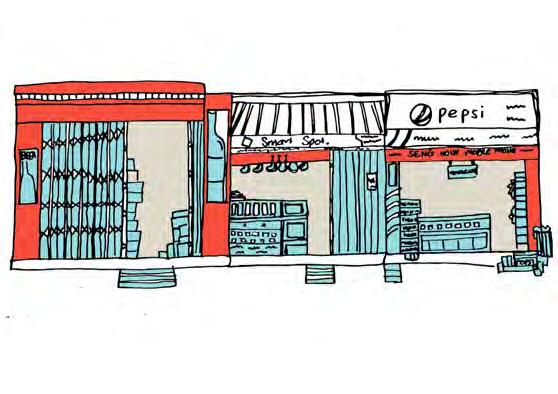
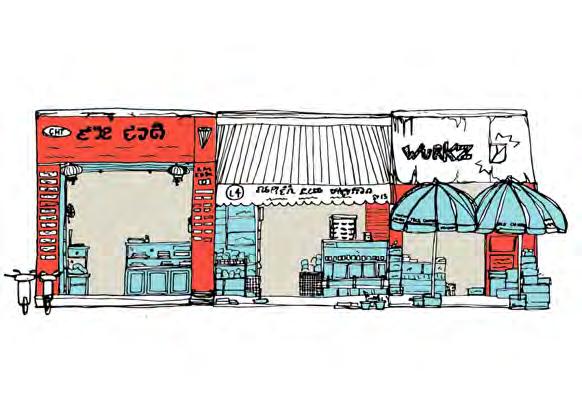
Observe the porosity of several internal/external building thresholds. How does the porosity of the threshold affect streetlife?
Emma Hastie, 2nd yr, Interior Architecture (Hons)
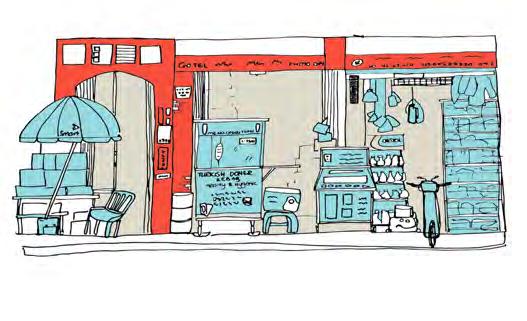
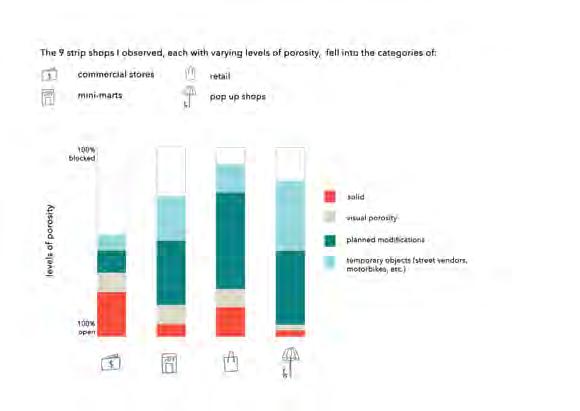
STREET LIFE STUDIES 2018/19 Built Environment, University of New South Wales, Sydney. Architecture and Urbanism, Royal University of Fine Art, Phnom Penh. Course Coordinator EVA LLOYD
response Main Street Bottle Shop, Phone Shop, Everything Shop | Side Street | Pop up store, Warehouse with Kebabs, Mechanics 12pm | Main Street | Money Exchange, Phone Shop, Mini Mart THRESHOLD POROSITY Layers Focus area Author planned modified activities users City sidewalk/road facade in/out threshold Phnom Penh Emma Hastie
Critical
Accessible Elevation 03 | 9am | Main Street | Bottle Shop, Phone Shop, Everything Shop Elevation 01 | 2pm | Side Street | Pop up store, Warehouse with Kebabs, Mechanics Elevation 02 | 12pm | Main Street | Money Exchange, Phone Shop, Mini Mart THRESHOLD POROSITY
Modified
SYDNEY
The diagrams represent components on facades ‘ What’ in three different sites that have been modified by users. The components have been categorized and highlighted.
Facade user modifications


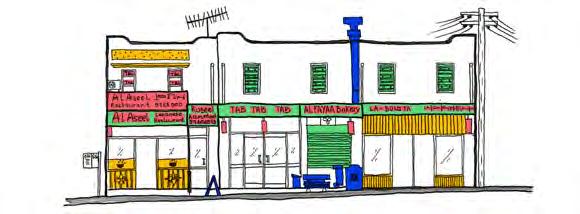

The diagrams represent components on facades ‘ What’ in three different sites that have been modified by users. The components have been categorized and highlighted.
The diagrams represent components on facades What’ in three different sites that have been modified by users. The components have been categorized and highlighted.
In data diagrams, each component has been counted and classified in terms of drivers behind ‘Why’ . Moreover, ‘Fixed and moveable’ components are also the focused points. It can be seen that some items need to be placed in a particular period of time to be used while some elements are permanently installed. Through this process, we could understand more what the points of modifications are and how effective the components can respond to the needs and the drivers.
Observe several facades.










What changes are being made by users? Why?





In data diagrams, each component has been counted and classified in terms of drivers behind ‘Why’ . Moreover, ‘Fixed and moveable’ components are also the focused points. It can be seen that some items need to be placed in a particular period of time to be used while some elements are permanently installed. Through this process, we could understand more what the points of modifications are and how effective the components can respond to the needs and the drivers.


In data diagrams, each component has been counted and classified in terms of drivers behind ‘Why’ Moreover, ‘Fixed and moveable’ components are also the focused points. It can be seen that some items need to be placed in a particular period of time to be used while some elements are permanently installed. Through this process, we could understand more what the points of modifications are and how effective the components can respond to the needs and the drivers.
Sidath Cheang, Architectural Studies (Master)

STREET LIFE STUDIES 2018/19. Built Environment, University of New South Wales, Sydney. Architecture and Urbanism, Royal University of Fine Art, Phnom Penh. Course Coordinator EVA LLOYD
1 2 3 4 5m Planed/Context interior comfort Signage Personal preference Shade Loose furniture
| 4:00 pm | Al Aseel Restaurant,
Shop,
Sunny/hot
| 4:00 pm | Darullalam
Restuarant | Sunny/hot
| 4:00 pm | RS Store
Restaurant,
Sunny/hot
Data diagrams Critical response
Elevation
Russell Accountant, TAB
Al FAyhaa Bakery & La-Bonita Cloth Shop |
Elevation
accesory, Sana Grocery, CIFTS
Elevation
& Creameen Kebab
Lakemba |
Modified Facade For Appropriate Usage
Sidath CHHEANG
Privacy Service Identity Security Commerce Climate Drivers Signage Canopy Traps Railings Containers Awning Rollings Rollings Moveable Fixed Antennas Furniture Sydney Author City Focus area Layers sidewalk/road facade in/out threshold planned modified activities users Data diagrams Critical response 1 2 3 4 5m Planed/Context interior comfort Signage Personal preference Shade Loose furniture Elevation 4:00 pm | Al Aseel Restaurant, Russell Accountant, TAB Shop, Al FAyhaa Bakery & La-Bonita Cloth Shop | Sunny/hot Elevation 4:00 pm | Darullalam accesory, Sana Grocery, CIFTS Restuarant Sunny/hot Elevation 4:00 pm | RS Store & Creameen Kebab Restaurant, Lakemba | Sunny/hot Sidath CHHEANG
Facade
Usage
Modified
For Appropriate
Privacy Service Identity Security Commerce Climate Drivers Signage Canopy Traps Railings Containers Awning Rollings Rollings Moveable Fixed Antennas Furniture Sydney Author City Focus area Layers sidewalk/road facade in/out threshold planned modified activities users
diagrams Critical response 1 2 3 4 5m Planed/Context interior comfort Signage Personal preference Shade Loose furniture Elevation | 4:00 pm | Al Aseel Restaurant, Russell Accountant, TAB Shop, Al FAyhaa Bakery & La-Bonita Cloth Shop | Sunny/hot Elevation | 4:00 pm | Darullalam accesory, Sana Grocery, CIFTS Restuarant | Sunny/hot Elevation | 4:00 pm | RS Store & Creameen Kebab Restaurant, Lakemba | Sunny/hot
Data
Facade
Usage
For Appropriate
Service Identity Security Commerce Climate Drivers Signage Canopy Traps Railings Containers Awning Rollings Rollings Moveable Fixed Antennas Furniture users
PHNOM PENH Facade user modifications
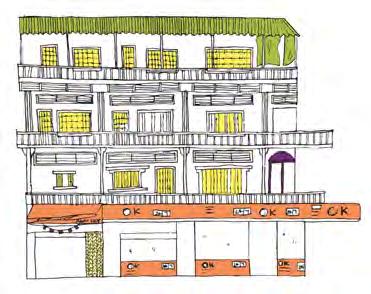 Evangeline Hannah
Phnom Penh Cambodia
Evangeline Hannah
Phnom Penh Cambodia
Observe several facades.
What changes are being made by users? Why?

After observing the facades of Phnom Penh, my research led me to the conclusion that the most user appropriations were made for commerce and security for chains and personalisation and weather for one-off stores.
Why? A chain store, has a universal look, which is easy to identify so their image is already established. Chain store owners modify their facades to ensure their premises are secure and noticeable to draw customers in. One-off store owners perhaps work everyday. They want to be protected from the elements whilst also building up their own facade style. Whether this is intentional or not, one-off stores end up creating a more eye-catching facade with their amalgamtion of sun-shading objects and personal touches.
Evangeline Hannah, 2nd yr, Interior Architecture (Hons)
Facade elements and the drivers behind them for chain and one-off stores
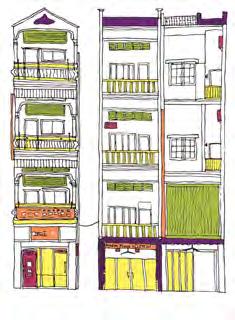
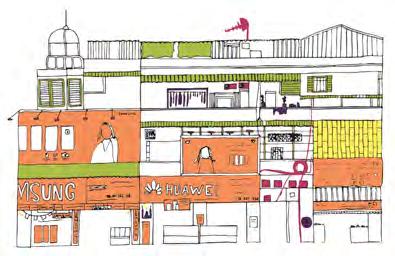
STREET LIFE STUDIES 2018/19 Built Environment, University of New South Wales, Sydney. Architecture and Urbanism, Royal University of Fine Art, Phnom Penh. Course Coordinator EVA LLOYD
1 2 3 4 5m Data diagrams Critical response security electric signage weather personalised planned Left Elevation | Planned & Modified Circle K & Phnom Penh Hiltton Bar user appropriations Right Elevation | Planned & Modified Facade of Pawn Shop & KiwiMart
| Planned & Modified Facade of Samsung, Huawei & Miscellaneous shop
Modifications planned modified activities users sidewalk/road facade in/out threshold Layers Focus area City
diagrams
Elevation
Facade
Author
1 2 3 4 5m Data diagrams Critical response security electric signage weather personalised planned Left Elevation | Planned & Modified Circle K & Phnom Penh Hiltton Bar user appropriations
Elevation | Planned & Modified Facade of Pawn Shop & KiwiMart
Right
Facade
Modifications
Elevation | Planned & Modified
of Samsung, Huawei & Miscellaneous shop Facade
SYDNEY
Threshold Activity

Lakemba, Sydney Emma Hastie
Activity Fixed Modifications Temporary Modifications THRESHOLD ACTIVITY Butcher | Haldon St Plan 01 | 2pm | Mahi Halaal Butcher | Haldon St Monde | Haldon St Plan 02 | 2pm | Cafe du Monde| Haldon St Plan 03 | 2pm | Islamic popup outside Women’s Centre | Haldon St popup outside Women’s Centre |


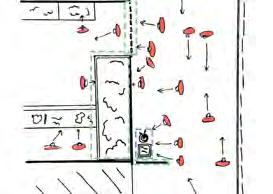

Critical response
| Mahi
Observe several road/sidewalk/interior thresholds. What activity occurs on and across these thresholds? How does the physical environment allow or inhibit certain activities?
On Haldon street, Cafe du Monde accomodates planned threshold activity through tables and chairs placed on the threshold for customerslocal men sit outside, smoke and chat to friends passing by. The wide footpath accomodates seating and walking space. An incidental threshold activity can be seen outside the Women’s Centre, where a few men set up a temporary stand giving away Islamic material. The inbuilt concrete bench and recessed spot under cover, with the council bench opposite, make this the perfect place to set it up. Passer-bys look, stop, and talk to the men. The butcher houses a few plants in boxes on its threshold, under the large bright window that causes people to look inside and slow down. The lack of signage and relation to the interior makes people curious, and they venture inside to ask.
Emma Hastie, 2nd yr, Interior Architecture (Hons)

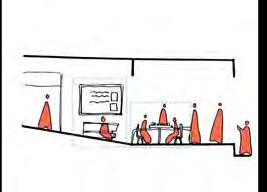
STREET LIFE STUDIES 2018/19. Built Environment, University of New South Wales, Sydney. Architecture and Urbanism, Royal University of Fine Art, Phnom Penh. Course Coordinator EVA LLOYD
Layers Focus area Author sidewalk/road facade in/out threshold planned modified activities users
Data diagrams City 1 2 3 4 5m
Activity Fixed Modifications Temporary Modifications THRESHOLD ACTIVITY Section 01 | 2pm
Halaal Butcher | Haldon St Plan 01 | 2pm | Mahi
Section 02 | 2pm | Cafe du Monde | Haldon St Plan 02 | 2pm | Cafe du Monde| Haldon St Plan 03 | 2pm | Islamic popup outside Women’s Centre | Haldon St Section 03 | 2pm | Islamic popup outside Women’s Centre | Haldon St facade in/out threshold modified activities users
On Haldon street, Cafe du Monde accomodates planned threshold activity through tables and chairs placed on the threshold for customerslocal men sit outside, smoke and chat to friends passing by. The wide footpath accomodates seating and walking space. An incidental threshold activity can be seen outside the Women’s Centre, where a few men set up a temporary stand giving away Islamic material. The inbuilt concrete bench and recessed spot under cover, with the council bench opposite, make this the perfect place to set it up. Passer-bys look, stop, and talk to the men. The butcher houses a few plants in boxes on its threshold, under the large bright window that causes people to look inside and slow down. The lack of signage and relation to the interior makes
Halaal Butcher | Haldon St
Data diagrams 1 2 3 4 5m
Critical response
PHNOM PENH Threshold Activity
Critical Response
Observe several road/sidewalk/interior thresholds. What activity occurs on and across these thresholds? How does the physical environment allow or inhibit certain activities?

 Allison Miller, 2nd yr, Interior Architecture (Hons)
Allison Miller, 2nd yr, Interior Architecture (Hons)

For observation #3, it studied the activity of how people interacted with each site. This looked at a comparison of a temporary pop-up site (site #1), a mixed site (site #2), and a permanent fixed site (site #3). As all three sites were very different in size and location, due to the time of the day - peak hour in the morning - and a busy corner, site #2 the most overall activity. It was a very congested site with a combination of pop up stalls, ‘make shift’ street parking for small motor / bikes and almost not enough seating for people willing to interact with the space (resturant and food carts). On the other hand, site #1 had the least amount of acitivty due to its lack of establishment and seating space.

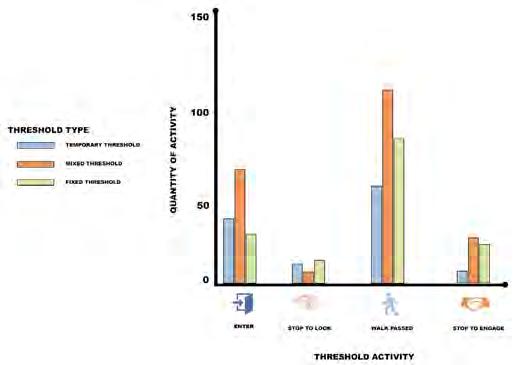
Data Diagrams
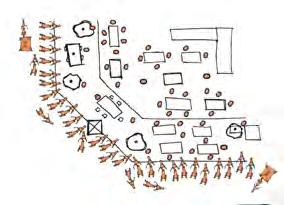

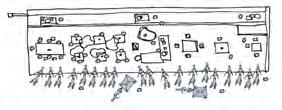
STREET LIFE STUDIES 2018/19 Built Environment, University of New South Wales, Sydney. Architecture and Urbanism, Royal University of Fine Art, Phnom Penh. Course Coordinator EVA LLOYD
planned modified activities users Layers Focus area City Author
PHNOM PENH ALLISON MILLER sidewalk/road facade in/out threshold
THRESHOLD ACTIVITY OBSERVATION 03: THRESHOLD ACTIVITY Section | 7:30am | Street 13 | Clear Plan | 2pm | 7:30am | Street 13 | Clear Section | 8:45am | Corner street 13 and 148 | Clear Plan | 8:45am | Corner street 13 and 148 | Clear Section | 5:45pm | Street 136 | Clear Plan | 5:45pm | Street 136 | Clear
City
DRAWINGS
DRAWINGSDRAWINGS
Threshold
SYDNEY
Threshold typologies


By breaking down the different items we see into planned or modified components we start to get an understanding of how different shops work. Further separating these into factors ,such as sensual stimulus, we can start to see trends with both stimuli and the thresholds they engage. Most shops operate on sight but the bigger the door, the more leakage there is. This creates a more diverse concept to porosity as the different sensation stimuli dont necessarily have a boundary but more of a radius shifting a shops threshold from interior and exterior to a more regional effect/description Number of objects
Observe several urban interior thresholds.



What are the key spatial charateristics and how does these relate to external/internal activities?

planned modified activities users
After observing an array of six different thresholds in this next set of shop fronts, it can be understood that the amount of objects on display on the pathway differed for each unit depending on the functionality of the space. The study displayed in the data below compares three main factors: the individual threshold size - both door and window openings, the percentage of blockages impacting the porosity of the facade, and how that was split into planned and modified objects. The percentgae of objects spilled onto the pathway were both blockages of the shops facade and furthermore narrowing the pathway for pedestrians, impacting the circulation of the space in the street. The clearest example is the jewllery store having displays only behind secured glass and therfore nothing on the path, compared to the fruit shops with an immense amount of fruit and vegetables in tall baskets for an interactive experience.

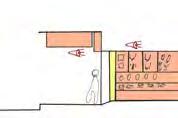

STREET LIFE STUDIES 2018/19. Built Environment, University of New South Wales, Sydney. Architecture and Urbanism, Royal University of Fine Art, Phnom Penh. Course Coordinator EVA LLOYD
Raeshaan Goh, 2nd yr, Industrial Design (Hons)
Layers Focus area Author sidewalk/road facade in/out threshold
LAKEMBA, NSW ALLISON MILLER
Railway Parade, Lakemba | Clear
REMAINING
SPACESHOP FRONT TEMP. OBJECTS Data Diagrams Layers Focus area Author Data diagrams Critical response City 1 2 3 4 5m planned modified sidewalk/road in/out threshold Lakemba Raeshaan Goh Planned items Modified items
PATH
Section 3: Open doorway shops
Section 2: Double doorway shops
Section 1: single doorway shops
Typology
in view Doorway types Planned Modified Senses Engaged Sight Smell Hearing Touch
PHNOM PENH

Threshold typologies
Observe several urban interior thresholds. What are the key spatial charateristics and how does these relate to external/internal activities?

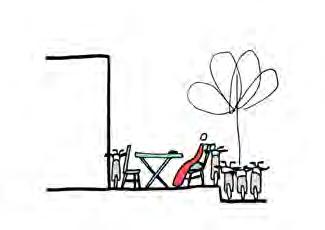
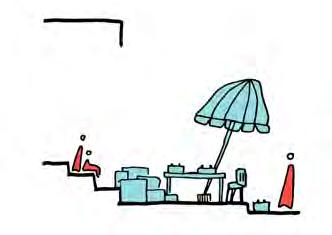


Emma Hastie, 2nd yr, Interior Architecture (Hons)

STREET LIFE STUDIES 2018/19 Built Environment, University of New South Wales, Sydney. Architecture and Urbanism, Royal University of Fine Art, Phnom Penh. Course Coordinator EVA LLOYD
Users Modifications THRESHOLD TYPOLOGIES Section 01 | 12pm | Money Exchange | Section 02 | 3pm | Pop up Kitchen | Section 03 | 9am | Warehouse with Kebab Stall | Section 04 | 2pm | Car Battery Pop up Store | Section 05 | 3pm | Construction Site with Parking Attendants Section 06 | 2pm | Mini Mart with Street Vendor|
empty up to onto space Food seatPenh pedestrian more had threshold
Layers Focus area sidewalk/road facade in/out threshold planned modified activities users
SYDNEY
Fence Activity





Observe several fences and the activity on/around them. How do the physcial features of the fence allow or inhibit this activity?
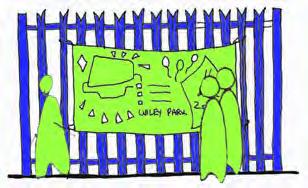
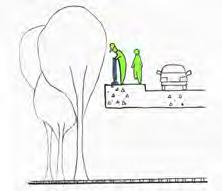
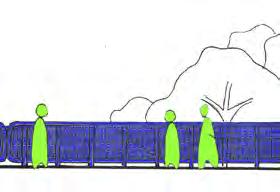

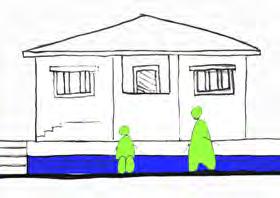
Ribus, quis eos ni aliquat ibusapiciam, sitas quam cum et eum dunde pos esto dolupta earum seque quatur? Qui dolest eostem hario mi, conseque prehenisci tem elestotas perepti ratatus, omnimpe rspient rempossime non eum, sinctemquis dolum sit volorepro maximagnis sunt que ni iuntota tquae. Ut quamus, offici dolupitio voloria comniss iminus re earchitassit volorae pedigen tendiandis ea est res as suntiation periae mod most utecat.
Ribus, quis eos ni aliquat ibusapiciam, sitas quam cum et eum dunde pos esto dolupta earum seque quatur? Qui dolest eostem hario mi, conseque prehenisci tem elestotas perepti ratatus, omnimpe rspient rempossime non eum, sinctemquis dolum sit volorepro maximagnis sunt que ni iuntota tquae. Ut quamus, offici dolupitio

As seen in the previous observations, the factors of porosity and height of fences did indeed have an effect on users. Taller semi-porous fences allow people to hang banners and lower fences allow people view the other side. Taller non-porous fences allow shade but also can create a sense of repulsion and security; shutting people out of the area. Shorter non-porous fences however created an opportunity to sit, rest and chat, whilst also creating a boundary around a specific area.
Sylvia Chen, 4th yr, Interior Architecture (Hons)


STREET LIFE STUDIES 2018/19. Built Environment, University of New South Wales, Sydney. Architecture and Urbanism, Royal University of Fine Art, Phnom Penh. Course Coordinator EVA LLOYD
1 2 3 4 5m fence activity Elevation | 9.00am | Side street | Sunny, hot FENCE ACTIVITIES Elevation | 9.00am | Main street | Sunny, hot Elevation | 9.00am | Back alley| Sunny, hot
planned modified activities users porosity typology activities Layers Focus area City Author Data diagrams Critical response
Sydney Sylvia Chen
Residential Multi-residential Public space Ornament Metal Brick Wire Metal Sitting Walking Viewing/stopping Standing/shade Graffiti
Author
PHNOM PENH Fence Activity
 Phnom Penh, Cambodia Farros Ghozi Fatih Djojodihardjo
Phnom Penh, Cambodia Farros Ghozi Fatih Djojodihardjo
Observe
several
fences and the
activity
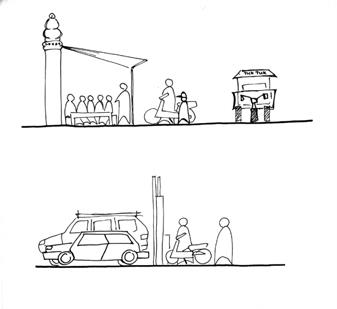

on/around
them. How do the physcial features of the fence allow or inhibit this activity?


 Farros Ghozi Fatih Djojodihardjo, 2nd yr, Architectural Studies
Farros Ghozi Fatih Djojodihardjo, 2nd yr, Architectural Studies
In observation three we studied how the fence can be an agent to hosting activities in teh surrounding area. aside from just creating a perimeter for certain activities, elements from th efence can be utilized to facilitate activities such as hanging merchandise on the fence, or tying tarpaulin on the fence to create a shaded environment. From this observation we learn that fences can host simple activities such as di erentiation parking betwen large to small vehicles, or othe types such as chain mail is most frequent in market areas were as the stupas of a temple’s fence can be anchors for shading system to host areas to eat street food. Without the chain mail or stupa it may result to di erent activities hosted by thge fence.
STREET LIFE STUDIES 2018/19 Built Environment, University of New South Wales, Sydney. Architecture and Urbanism, Royal University of Fine Art, Phnom Penh. Course Coordinator EVA LLOYD
People
ELEVATION| Market near St 13 | Sunny ELEVATION| Tax Office | Sunny SECTION| Tax Office | Sunny ELEVATION| Street 13 Temple | Sunny Layers Focus area planned modified activities users diagrams response City sidewalk/road facade in/out threshold
Observation Three
$ $ $ Legend walking by waiting in the shade car drive by sitting on milk crates standing stopping selling tuk tuk drive by parkerd car parked tuk tuk Location: Temple Location: Office Location: Market parked motor cycle motor cycle drive by 36% 35% 29% 3 2 15 6 4 2 2 2 2 3 3 1 1 2 10 8 6 3 10 4 1 6 Elevation| Elevation
EMERGENT THEMES
Can observation and documentation be a means of identifying parts of a city deemed of value in preserving amidst development?
How are fences repurposed by owners and street users?
What role can signage play in urban expression?
How do people interact across urban interior thresholds?
Are the informal and nonphysical parts of a street as important in the heritage and culture of a city as the formal and physcial parts?
What role can materials play in personal expression on the street?
How and why are awnings adorned by their users?
How does furniture affect the use of public private thresholds?
How do fences use material and detail to express fear, ownership, status, identity?
How do personal objects contribute to the narrative of a city?
What have street users told us about their priorities in the street?
How do the details of an object afford certain functions?
Do the markings of a city in construction contribute to its identity? Should they remain?
How are monuments used in cities?
How does the width of the street affect the environment for its users?
How does the ‘porosity’ of a facade affect street life? Why do certain spaces attract individuals verses groups?
STREET LIFE STUDIES 2018/19. Built Environment, University of New South Wales, Sydney. Architecture and Urbanism, Royal University of Fine Arts, Phnom Penh. www.streetlifestudies.wordpress.com
phase 2: streetlife intervention
In phase two of the course, students use their observational findings as ‘evidence’ to develop a design brief and proposal for an urban intervention in either Sydney or Phnom Penh. The overall goal is to create a small, scalable intervention that acts as a social catalyst in improving or supporting street life.

Students are challenged to think beyond intervention as a physcial construct ‘delivered’ by designer to systems developed and maintained with and for the people who use them.
Working within their observational theme students begin with group workshops. The reflect on their observations to identify opportunities and constraints that lead to the development of a design brief. In response, they work individually to propose an intevention, pitched through a simple image and short presentation.
STREET LIFE STUDIES 2018/19. Built Environment, University of New South Wales, Sydney. Architecture and
University of
www.streetlifestudies.wordpress.com
Urbanism, Royal
Fine Arts, Phnom Penh.
"Construct situations rather than objects, design processes that can result in chance meetings ...leaving room for users to adapt and appropriate space."
Atelier Bow Wow
PHNOM PENH ‘Slim Shady’
Issue
Response brief
Underutilised alleyways
Activate alleyways for multi-use functionality by primary demographic in area- children, women living in the alleyway, and waiting tuk tuk and moto drivers


Considerations
Access, maintaining natural light, safety, maitenance
STREET LIFE STUDIES 2018/19 Built Environment, University
of New South Wales, Sydney. Architecture and Urbanism, Royal University of Fine Art, Phnom Penh. Course Coordinator EVA LLOYD
Mesha Nazareth, 3rd yr, Interior Architecture (Hons)
PHNOM PENH ‘Lanewaste’ system
Encourage people to practice and lead a cleaner
Evidence
Width and height of alley ways in comparision to the size of the Cintri truck

Issue
Issues:
- Poor air quality on the street
Waste filled laneways. No formal waste collection due to width of trucks. Plus, decreasing work for moto drivers with new ‘PassApp’ transport system
- Inefficient system of waste management

- Behaviour of residents regarding disposal of waste

Response brief
How does it improve streetlife by:
- Improve the streetscape and healthier living environment
- Repurpose the intersection of the main street and the alley way by getting rid of the dumping ground

Factors to consider:
Create a waste collection system for laneways, run by moto drivers, that connects to public waste collection on main streets

- For this to be successful, behavioral changes of residents regarding disposal of waste
- Education of residents about the importance of this system
CINTRI truck access to the alley way is impossible due to the width being too narrow and low height because objects are placed out onto the street by residents.
- Encourage people to practice and lead a cleaner lifestyle

Considerations
and
alley ways in comparision to the size of the Cintri truck
Education of residence for behaviour change, theft of bins, space for bins, ease of attachment to motos

According to the research done in observation 2, there was a clear lacking in the number of trash bin in the alley way, which indicates a poor waste management system in the area.
Waste collection motorcycle
way is
due to the
Monyneath Chan, 3rd yr, Architectural Studies
According to the research done in observation 2, there was a clear lacking in the number of trash bin in the alley
STREET LIFE STUDIES 2018/19 Built Environment, University of New South Wales, Sydney. Architecture and Urbanism, Royal University of Fine Art, Phnom Penh. Course
EVA LLOYD
Coordinator
Monyneath Chan
lifestyle
motorcycle 2m 3.5m 4m 2m 2m 2m 2.2m 3m
Main Street Alley
sunsmell water
disposal of waste by residents
Cintri unlocks the trash bin from the hook that is fixed to the wall
Cintri hooks trash bin to trash bin then to the back of the motorcycle
> > > Process
Cintri takes the trash bins out from the alley way to the Cintri truck
6am-12am Residents Timeframe Users City Author Phnom
Monyneath
2m 3.5m 4m 2m 2m 2m 2.2m 3m
Penh
Chan
Main Street Alley
CINTRI truck access to the alley
impossible
width being too narrow and low height because objects are placed out onto the street by residents.
sunsmell
water
Width
height of
PHNOM PENH The Bookcart
Issue
Few protected places to stop and sit on sidewalk. Opportunity to support educational focus of Pagodas.
Response brief
Create sheltered places to stop with an educational focus, for tourists and local students.
Considerations
Protection from rain/sun, theft, maitenance
THE BOOKCART
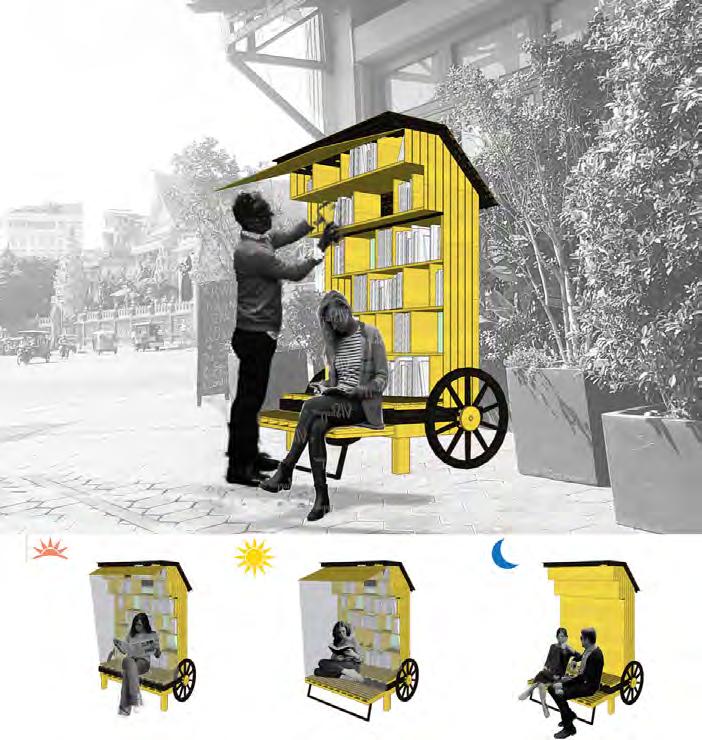
Tang Mouychou

STREET LIFE STUDIES 2018/19
Built Environment, University of New South Wales, Sydney. Architecture and Urbanism, Royal University of Fine Art, Phnom Penh. Course Coordinator EVA LLOYD
Tang Mouychou, 5th yr Architecture and Urbanism, RUFA
Ellie Skinner Phnom Penh Community AerobicLovers Sunrise/Sunset
GOAL
PHNOM PENH Rooftop Aerobics
- To activate street life on upper levels (Rooftop) which, when looking up from the streets, are noticeably more quiet and unused
- To create an activity (Sunset Aerobics) for community participation, that can otherwise not be done on the streets
- To transform an unused space (Old Market Roof) into a place with people and purpose
- To encourage further activation of vertical street-life
PROBLEM EVIDENCE
GOAL
PROPOSAL
My observations showed that there was lack of facade activity, in comparison to street level activity.
Issue
This absence of ‘street life’ on upper levels is often due to…
Response brief
Heat. Hot air rises and there is often no modifications made to the facade to aid this.
CONSIDERATION/SOLUTION
AUTHOR CITY USERS TIMELINE
Ellie Skinner Phnom Penh Community AerobicLovers Sunrise/Sunset
- To activate street life on upper levels (Rooftop) which, when looking up from the streets, are noticeably more quiet and unused

- To create an activity (Sunset Aerobics) for community participation, that can otherwise not be done on the streets

- To transform an unused space (Old Market Roof) into a place with people and purpose

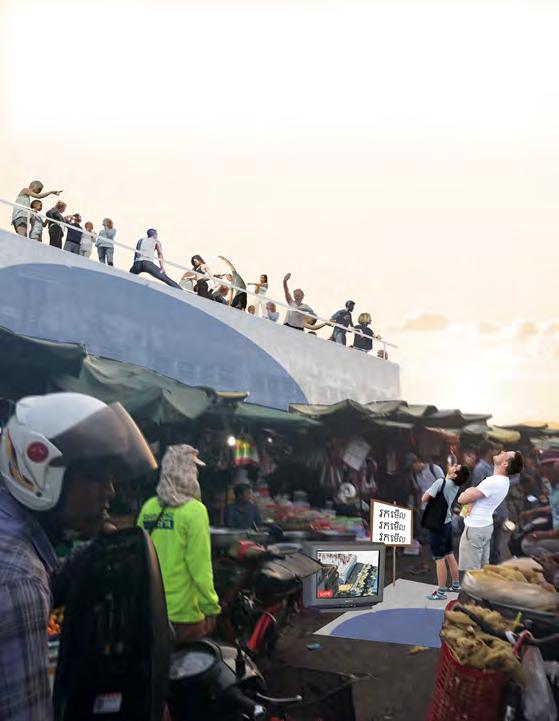
- To encourage further activation of vertical street-life
PROBLEM EVIDENCE
My observations showed that there was lack of facade activity, in comparison to street level activity.
Market Roof (unused)

+
This
absence of ‘street life’ on upper levels is often due to…
GOAL
Eleanor Skinner, 2nd yr, Interior Architecture (Hons), UNSW
CONSIDERATION/SOLUTION
To combat this my rooftop activity will occur at sunrise/sunset , a time that avoided the two main issues getting in the way of street life activity on upper levels. However, in this time, many community members enjoy Aerobics groups…

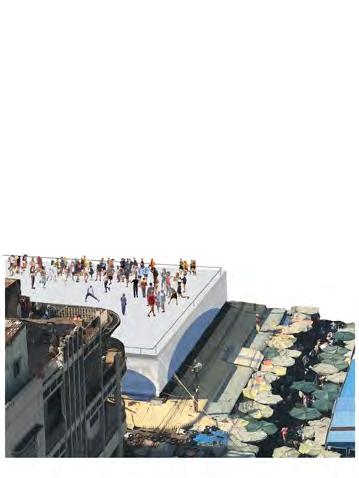
Old Market Roof (unused)
+ =
STREET LIFE STUDIES 2018/19 Built Environment, University of New South Wales, Sydney. Architecture and Urbanism, Royal University of Fine Art, Phnom Penh. Course Coordinator EVA LLOYD
Considerations AUTHOR CITY USERS TIMELINE
PROPOSAL
Work/Activity. Most businesses are located on the street. This means families and people will spend most time here
To combat this my rooftop activity will occur at sunrise/sunset , a time that avoided the two main issues getting in the way of street life activity on upper levels. However, in this time, many community members enjoy Aerobics groups… Old
EVIDENCE
Heat. Hot air rises and there is often no modifications made to the facade to aid this.
Work/Activity. Most businesses are located on the street. This means families and people will spend most time here
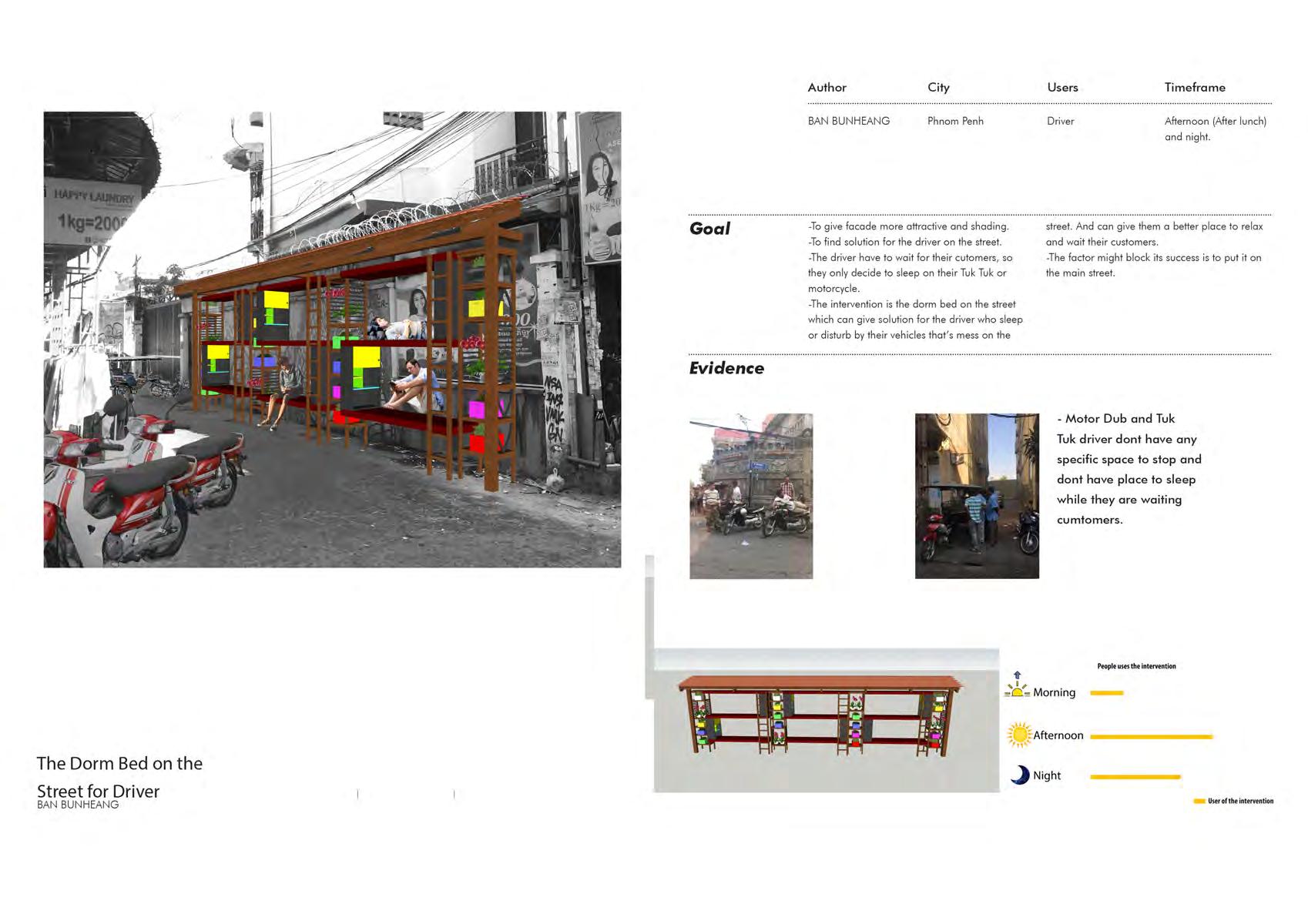


Built Environment, University of New South Wales, Sydney. Architecture and Urbanism, Royal University of Fine Art, Phnom Penh. Course Coordinator EVA LLOYD
PHNOM PENH
Outdoor mezzanine
ISSUE: The interiors and exterior of retail stores is not a space which customers are welcomed into, because stacked products which fill the entire space for efficient loading onto motors.The drivers are forced to wait out in the sun on the street.


OPPORTUNITY: To create a space where drivers can rest in the shade, whilst still allowing the workers downstairs to efficiently use the threshold to organise and load products on vehicles.
Issue
IMPROVING STREET LIFE: To encourage people to interact with the threshold by sitting together. The intervention will aim to improve the facilitation for social interaction and use of space.
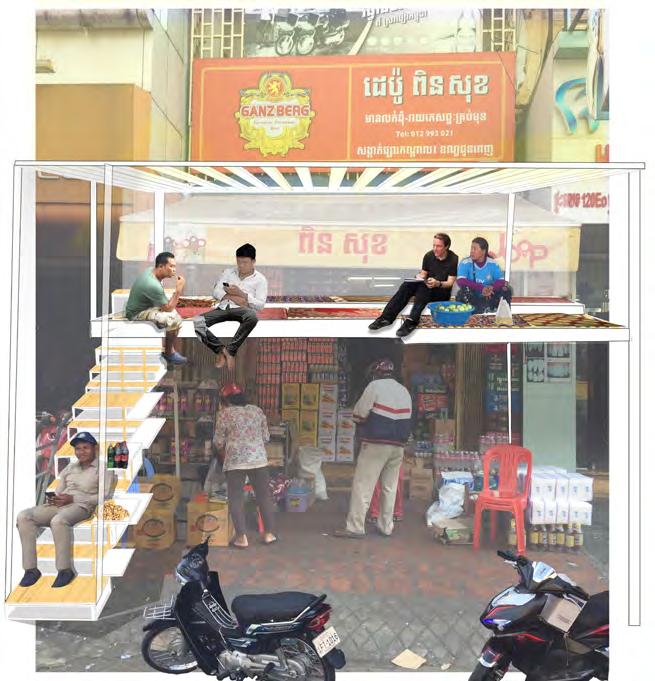
FACTORS TO BE CONSIDERED: As the urban intevention is off the ground the seating area not be used. People need to feel comfortable and protected from the sun to go into the space. Therefore, the stairs may also be used for quick stops for shorter periods or to ease people into the space.
Multiple delivery drivers wait for long periods on their motos/tuk tuks in the hot sun/rain whilst goods are unloaded.
Response brief
The standard shop house with a mezzanine level is added to the exterior of the threshold in this design
Considerations
Create a place to wait for delivery drivers that encourages social interaction between drivers.
Vertical access, protection from climate, impact on privacy of upper levels, signage to shop below
The graph depicts the amount of clutter means that less people are entering and using the space
Plan: Where are the people (Karaoke, Motor Shop, Food Retail)
The food retail shop facilitates large amounts of activity mostly on the exterior of the facade.
Hannah Blair, 2nd yr, Interior Architecture (Hons), UNSW
JUST HANG SHADY
STREET LIFE STUDIES 2018/19 Built Environment,
University of New South Wales, Sydney. Architecture and Urbanism, Royal University of Fine Art, Phnom Penh. Course Coordinator EVA LLOYD
Evidence permanent 6-6pm delivery times Tuk
delivery
Tuk, Car, Truck and Motor
drivers
Phnom Penh Hannah Blair
People V Objects on the threshold
The workers Tuk Tuk drivers
Hannah Blair


Built Environment, University of New South Wales, Sydney. Architecture and Urbanism, Royal University of Fine Art, Phnom Penh. Course Coordinator EVA LLOYD
getKandal about even the one because spend
PHNOM PENH Memory Fence
Issue Response brief Considerations
Destruction of cultural sites throughout the city with loss of embedded stories.

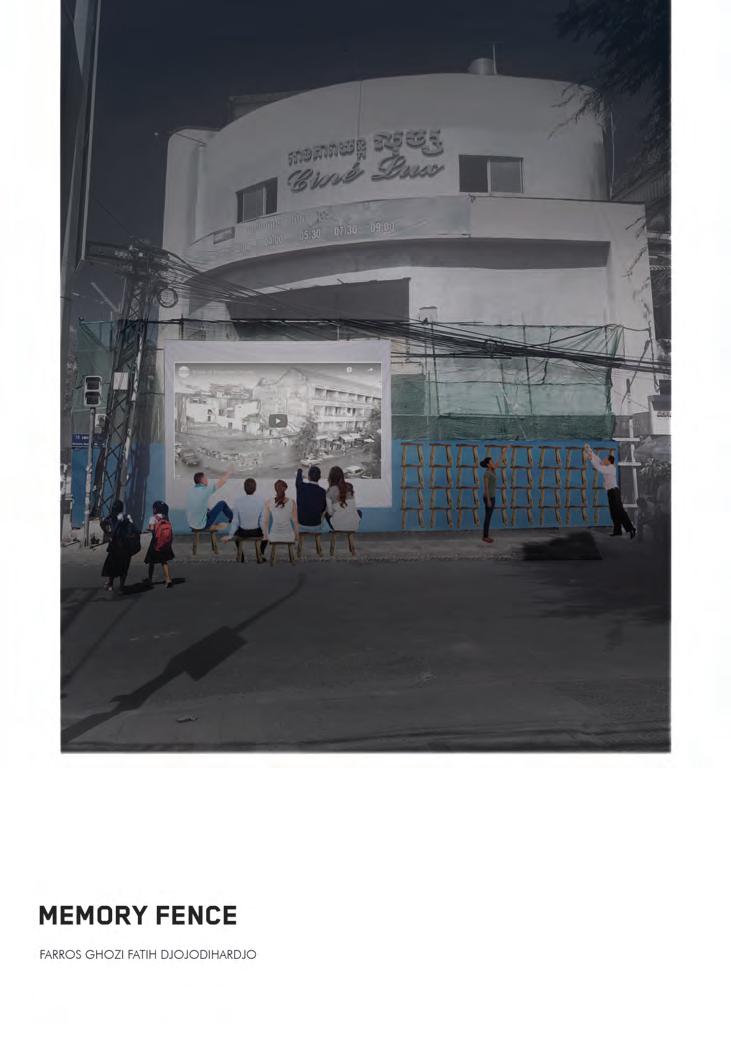
Layers Focus area sidewalk/road facade in/out threshold
Use construction fences to tell the stories of the places being lost behind the fence.
planned modified activities users
Government support, mobility, cost given temporary intervention
STREET LIFE STUDIES 2018/19 Built Environment, University
of New South Wales, Sydney. Architecture and Urbanism, Royal University of Fine Art, Phnom Penh. Course Coordinator EVA LLOYD
Farros Ghozi Fatih Djojodihardjo, 2nd yr, Architectural Studies
SYDNEY Little Library
Issue
Underutilised sidewalk spaces in back alleys and side streets, often filled with trash.

Response brief
Re-imagine the fences lining back alleys and sidestreets as places to stop, rest and socialise.
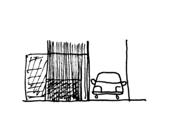
Considerations
this is a response to the general lack of activity in side streets and back alleys in Sydney provides an interactive fence where people are able to sit/rest/study/work encourages people to spend their time outdoors rather than inside

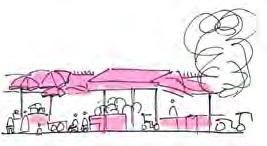
Exposure-how to bring people to these spaces? Cost, maitenance.
LITTLE LIBRARY
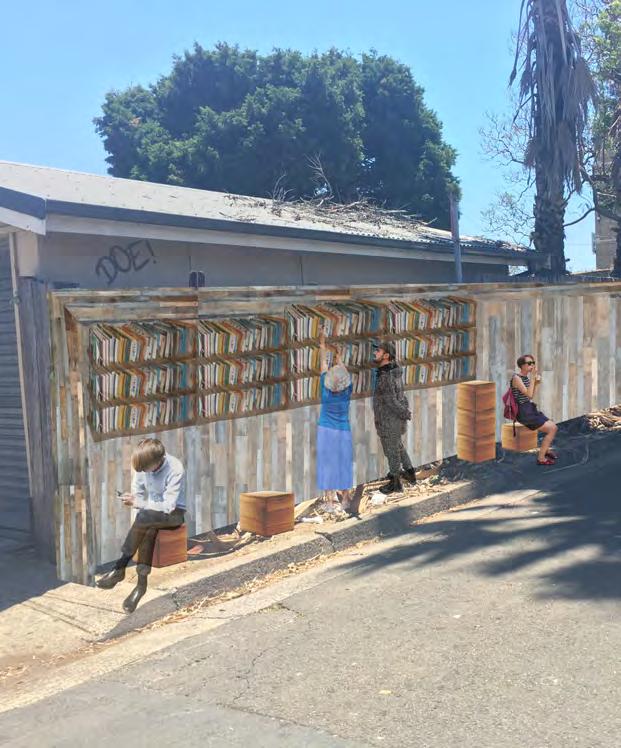
Built Environment, University of New South Wales, Sydney. Architecture and Urbanism, Royal University of Fine Art, Phnom
EVA LLOYD
Penh. Course Coordinator
Uyen Pham, 2nd yr, Interior Architecture (Hons)
Day time. Local residents.
Timeframe Users City Author Sydney Uyen Pham
Business and home life spills out onto the streets in Phnom Penh in side streets and back alleys in contrast with Sydney where there is little to no activity in similar areas.
SYDNEY vs PHNOM PENH
Evidence
PHNOM PENH
The Undiscovered
Issue
City Author
Response brief Considerations
ISSUE
Underutilised construction fences
Timeframe Users
Tourists mostly Any passerbys
Mainly during morning -afternoon (hottest time)
Re-imagine construction fences as places able to host multiple ‘stopping’ activities.
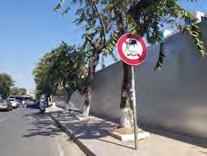

Cost, safety as near construction site
-Overpopulation of activities in certain areas of Phnom Penh rendered by the physcial features of the fence

RESPONSE
-Disperse the level of activity by creating a new layer of a ‘FENCE’ that facilitates activities
-Create a resting / community public space that can revitalise an unused space / fence
-Create opportunities for new artists to exhibit their work

CONSIDERATION
-Safety reasons within construction fence area
-Getting permission to build within a public area
-Finding areas that has enough space (walking space) to create this communal area.
Patternation & Porosity of fence allows users to utilise the fence as an agent of an activity
High fence and no patternation evidently facilitates no activities
STREET LIFE STUDIES 2018/19 Built Environment, University of New South Wales, Sydney. Architecture and Urbanism, Royal University of Fine Art, Phnom Penh. Course Coordinator EVA LLOYD
Yune Cho, 4th yr, Interior Architecture (Hons)
the undiscovered Yune Cho LOOK SIT STAND ART SHADE
Phnom Penh Sung Yune Cho
EMERGENT THEMES
What if gamification could be used to encourage short social exchange at bus stops?
What if functions were added to ‘activate’ back lane fences?
What if construction fences told the stories of a changing city?
How might we maintain unique city identities in the face of global development?
What if urban furniture could harness energy?
What if suburban fences were hosts to street events?
What if there were a facade system able to be adapted by users?
How might street users be involved in shaping our streets?
What if market rooftop spaces were used for recreation
What if ‘airspace’ in laneways was able to be used for play, rest and storage?
How might we ensure streets manage waste and are walkable without gentrifying?
What if sidewalks offered more than circulation space?
sydney
What if we were able to interact with public murals?
What if cities had small pockets of urban ‘forest’?
What if urban and interior spaces were connected by sensory mechanisms like smell?
What if the street were an outdoor classroom?
What if awnings collected and distributed energy?
How might we ensure our cities offer useable outdoor public space suited to climatic conditions?
PHNOM PENH
How might we maintain ‘informal’ streetlife as a core part of development?
What if moto drivers could help waste management systems access hard to reach communities?
What if sidewalk activities throughout the day could be organised through a flexible system?
What if fences were opportunities for play?
STREET LIFE STUDIES 2018/19. Built Environment, University of New South Wales, Sydney. Architecture and Urbanism, Royal University of Fine Arts, Phnom Penh. www.streetlifestudies.wordpress.com
CREDITS
For more information
www.streetlifestudies.wordpress.com #streetlifestudies
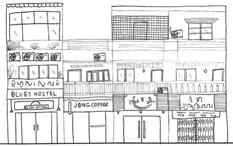

Eva Lloyd e.lloyd@unsw.edu.au
Giacomo Butte giacomo.butte.2@gmail.com
Richard Briggs honbriggsdesign@gmail.com

A sincere thank you to:
The University of New South Wales, Built Environment, for supporting the fourth installment of this international summer elective.
The Royal University of Fine Arts, Faculty of Architecture and Urbanism, for hosting the Phnom Penh contingent in their offer of space, staff, student volunteers and logistical help.
All students involved, who worked with dedication and rigour. The guest speakers and city of Phnom Penh, who offered invaluable insights and opened their spaces to us.
UNSW STUDENTS
Monyneath Farros Ghozi Fatih
Raeshaan
Theodore Bramantio
Hannah
Ellie
Evangeline
Allison
Sylvia
Panayiota
yune
Maral
Amy
Rebecca
Uyen
Mesha
Emma
Mayeesha
Anina
Sidath

RUFA students
UNSW staff
Guest talks and critique
Chan
Djojodihardjo
Goh
Hardiono
Blair
Skinner
Hannah
Miller
Chen
Achilleos
cho
Madanimelak
Smith
Donney
Pham
Nazareth
Hastie
Shafiq
Carl
Cheang
Tang Mouychou
Sopheap Sreymom
Tuy Soksonita
Hut Chhivmey
Try Seihakpeirom
Ly Visansocheata
Ung Socheata
Ban Bunheang
Chea Limkheang
Touch Sopanha
Thida Meouk
Ean Chhayna
So Bunnareach
Sarun Chan To
Phoumen Ranalaksmy
Sri Kimkorn
Chhav Pichhet
Keo Solinda
Lourng Kimfa
Chan Sophorn
Course coordinators/tutors
Eva Lloyd
Giacomo Butte
Richard Briggs
Director Interior Architecture
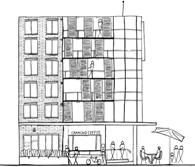



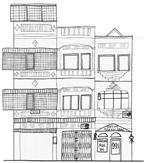
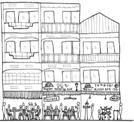
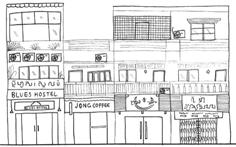

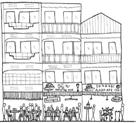
Lisa Zamberlan
Head of School
Bruce Watson
RUFA staff
Dean of Faculty
Professor Kong Kosal
Vice Dean of Faculty
Karno Chay
Logistical assistance
Phal Piseth
Lyno Vuth, Sa Sa Art Projects
Penserey Pagna, The Vann Molyvann Project
Site visits
Khmer Architecture Tours
Olympic Stadium
Photographic credits
Theodore Bramantio Hardiono
Farros Ghozi Fatih Djojodihardjo
Eva Lloyd
Richard Briggs
Above drawing: Karen Kong

UNSW Industrial Design student
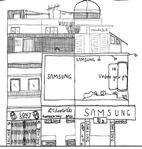
STREET LIFE STUDIES 2018/19. Built Environment, University of New South Wales, Sydney. Architecture and Urbanism, Royal University of Fine Arts, Phnom Penh. www.streetlifestudies.wordpress.com
P H N O M P E N S Y D N E Y P H N O M P E N H S Y D N E Y January 2017 - Starter Kit UNSW Brand Refresh Overview From the week of 16 January 2017 the University’s brand will be refreshed. New elements will be introduced to enhance the brand and increase design flexibility, whilst retaining the brand equity of elements such as the University crest and the yellow brand colour. Our brand guidelines will be updated to support this change to the University’s branding. The full suite of



































































































 Evangeline Hannah
Phnom Penh Cambodia
Evangeline Hannah
Phnom Penh Cambodia











 Allison Miller, 2nd yr, Interior Architecture (Hons)
Allison Miller, 2nd yr, Interior Architecture (Hons)



























 Phnom Penh, Cambodia Farros Ghozi Fatih Djojodihardjo
Phnom Penh, Cambodia Farros Ghozi Fatih Djojodihardjo



 Farros Ghozi Fatih Djojodihardjo, 2nd yr, Architectural Studies
Farros Ghozi Fatih Djojodihardjo, 2nd yr, Architectural Studies















































